
Annex 5
Narrative Interim Report
The report must describe in detail how the project has progressed and the results achieved so far, and must
describe how the project funds have been used for the planned activities. The total length should not exceed
15 pages.
BMZ Project number: 6815
Project country: South Africa
Project title: Community-Based Adaptation to Climate Change (CBCCA) to build resilience
Organisation: Mahlathini Development Foundation (MDF)
Project duration: 01.10.2022 bis 31.08.2025
Period: July-September 2023
1.General Information
The CbCCA project is based on working with Climate resilient Agriculture (CRA) learning groups of smallholder
participants. These groups are set up a at village level across three provinces: KZN, EC and Limpopo. They work
on an annual cyclical planning and review process for implementation of CRA practices (Field cropping,
homestead food production and livestockmanagement) –which are supported through training, mentoring
and implementation support. The intention is to support both existing learning groups in the three provinces to
deepen their implementation and to initiate new learning groups.
Figure 1: Map of SODI-CbCCA villages across EC, KZN and Limpopo

Project no 2116ZA311
2
CRA learning group members alsoundertake a range of other associated activities according to their need,
meaning that not all groups undertake the same activities:
➢Setting upand running village savings and loanassociations (VSLAs), with membership from the CRA
learning groups and beyond, for savings and small loans for consumption smoothing and productive
activities.
➢Enterprise development and local marketing committees and groups, mostly to run the joint monthly
produce markets in nearby towns, but also includes egg andbroiler production and sales, livestock
auctions and more formal market contracts.
➢Water access and management through water committees linked tolocalgovernance structures, for
planning and implementing integrated water management activities and
➢Livestock committees, for development of conservation agreements for rangeland management and
local livestock auctions.
The diagram below indicates the interactions with these local or micro level groups at the meso- level through
clusters and platforms with multiple stakeholders and at the meso- and macro level through more formalized
organizational forums and networks.
Figure 2: The micro-, meso- and macro-level interactions for the CbCCA programme and the Communities of
Practice (COPs).
Quarterly project reports outline the training, field-based activities undertaken with the CRA learning groups
and their progress related to economic empowerment (VSLAs, marketing etc.). Information on activities related
to the innovation and multistakeholder platforms is also to be included in summary form.
Integrated water and natural resources management activities are more discreet in nature and will be reported
on as progress is made. This also applies to the development of evidence-based indicators and the monitoring
and evaluation handbook development.
1.1.Project Description / Project Objectives
The COVID-19 pandemic, global economic downturns and internal political and economic instability have
exacerbated the already significant negative impact of climate change on smallholder farmer communities in
South Africa. Unemployment is very high (60-80%), with very low incomes primarily through social grants
(around R2000/month per household of 4-5 members). Smallholders need to find ways to provide for a
sustainable livelihood forthemselves through farming andresource use in their villages. The climate resilient
agriculture practices have been piloted and have been shown to significantly improve both livelihoods and
social agency and now needs to be deepened and expanded.

Project no 2116ZA311
3
The project objectives and outputs are summarized in the small table below.
Overall objective
(impact)
Communities have improved their livelihoods and their capacity to adapt to climate change and
have strengthened their resilience climate change risks and shocks
Project
outputs/objectives
O1
Capacity is developed for creation of and strengthening institutional frameworks and
mechanisms for including proven multi-benefit approaches that promote collective action and
coherent Community based Climate Change Adaptation (CbCCA) implementation.
O2
The farmer level decision support system for implementation of CRA is upscaled in eastern SA.
O3
Appropriate frameworks for monitoring and evaluationof environmental benefits and agro-
ecosystem resilience are developed at multiple scales
O4
Improvement of water and natural resources management and governance through
community ownership
1.2.Source of Information
Each activity setwithin the projecthas afocused monitoring and evaluation process, to encompass therange
of environmental, agricultural, economic and social indicators used for reporting. Monitoring forms include for
example the CCA baselines, crop and garden monitoring, poultry production monitoring and fodder
supplementation monitoring. Databases are collated for the monthly VSLA (village savings and loan
associations) recordsand monthly market stall sales and incomes. Seasonal reviews for each learning groups
consist of focusgroup discussions and individual interviews. Resilience snapshots and participatory impact
assessments provide more summative evaluative content.
In addition, the provincial field team leaders (Betty Maimela and Mazwi Dlamini) provide monthlyreports on
training and implementation undertaken with the CRA learning groups. Photographs are included in these
summaries and attendance registers are available. All interns are expected to provide monthly field work
reports (for SODI – Sphumelelo Mbhele) and reports for events, workshops and meetings are submitted.
Erna Kruger usesthese reports and databases to compile the SODI quarterly reports for the organization.
Financial reports re compiled jointly by Erna Kruger and Sarika Ramsewak.
2.Project Status
Overall Objective (Impact): Communities are empowered toadapt to climate change and their resilience is
strengthened.
Project Objective
(Outcome):
Indicator
Base value
(quantitative & qualitative)
Equivalent to proposal
Target value
(Quantitative & qualitative)
Equivalent to proposal
Achievements
(quantitative & qualitative)
Smallholder families in 3
provinces in South Africa
apply climate-adapted
agricultural practices and
diversify their income
opportunities in order to
stabilize food security in
the long term.
As part of an MDF pilot
project, 345 smallholder
farmers have gained
initial experience with
local agricultural practices
for climate change
adaptation. There is
currently no coherent
regional orlocal system
for climate-adapted
agriculture by smallholder
2,625 beneficiaries of
smallholder farming
families and 75
stakeholders in 3 provinces
are organized in
Communities of Practice
(CoP) and implement at
least 3 practices for
climate-adapted agriculture
according to developed
standards.
809participants, of whom173
are in new learning groups
(4 045 beneficiaries)
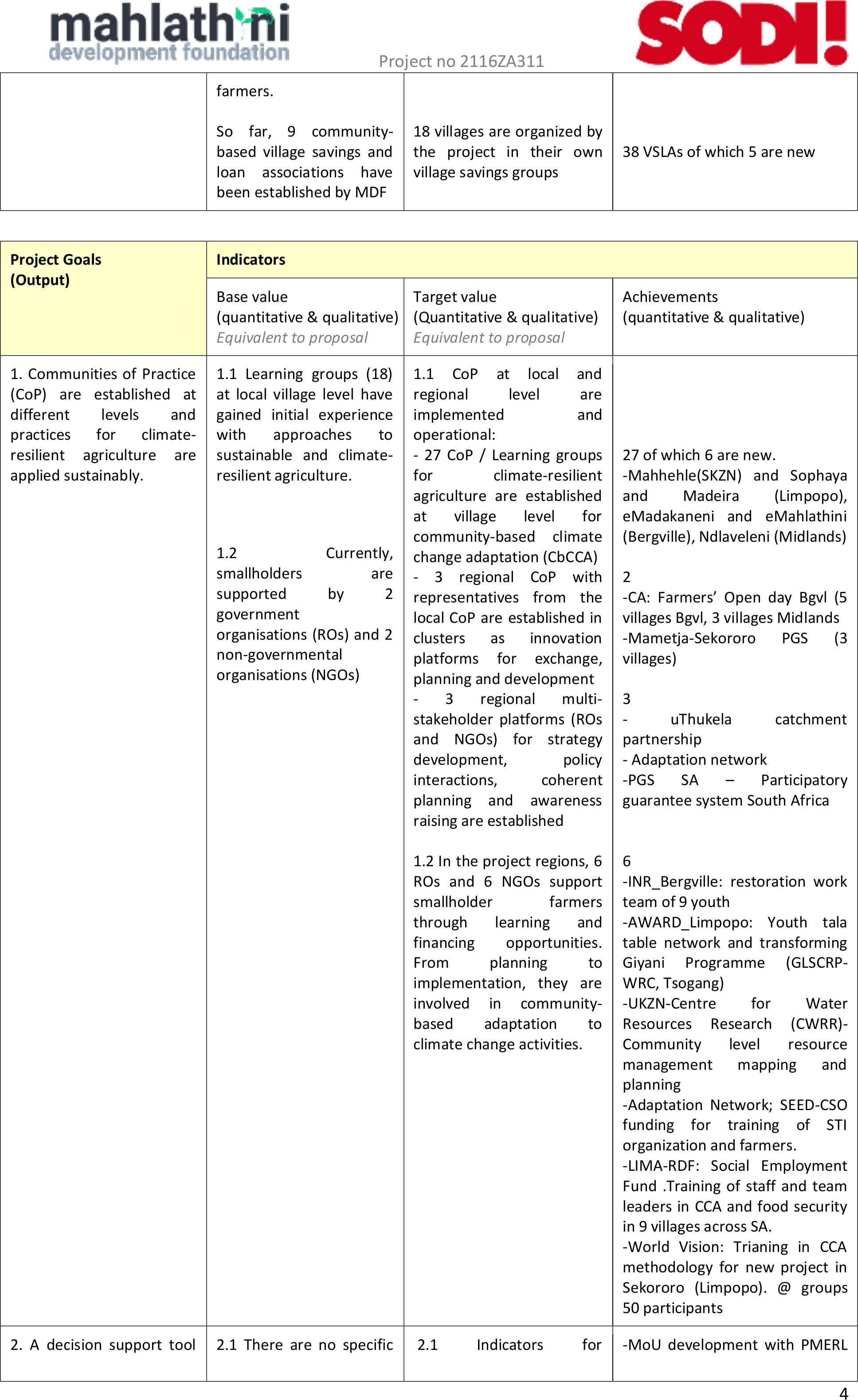
Project no 2116ZA311
4
Project Goals
(Output)
Indicators
Base value
(quantitative & qualitative)
Equivalent to proposal
Target value
(Quantitative & qualitative)
Equivalent to proposal
Achievements
(quantitative & qualitative)
1. Communities ofPractice
(CoP) are established at
different levels and
practices for climate-
resilient agriculture are
applied sustainably.
1.1 Learning groups (18)
at local village levelhave
gained initial experience
with approaches to
sustainable and climate-
resilient agriculture.
1.2 Currently,
smallholders are
supported by 2
government
organisations (ROs) and 2
non-governmental
organisations (NGOs)
1.1 CoP at local and
regional level are
implemented and
operational:
- 27 CoP / Learning groups
for climate-resilient
agriculture are established
at village level for
community-based climate
change adaptation (CbCCA)
- 3 regional CoP with
representatives from the
localCoP are established in
clusters as innovation
platforms for exchange,
planning and development
- 3 regional multi-
stakeholder platforms (ROs
and NGOs) for strategy
development, policy
interactions, coherent
planning and awareness
raising are established
1.2 In the project regions, 6
ROs and 6 NGOs support
smallholder farmers
through learning and
financing opportunities.
Fromplanning to
implementation, they are
involved in community-
based adaptation to
climate change activities.
27 of which 6 are new.
-Mahhehle(SKZN) and Sophaya
and Madeira (Limpopo),
eMadakaneni andeMahlathini
(Bergville), Ndlaveleni (Midlands)
2
-CA: Farmers’ Open day Bgvl (5
villages Bgvl, 3 villages Midlands
-Mametja-Sekororo PGS (3
villages)
3
- uThukela catchment
partnership
- Adaptation network
-PGS SA –Participatory
guarantee system South Africa
6
-INR_Bergville: restoration work
team of 9 youth
-AWARD_Limpopo: Youth tala
table network and transforming
Giyani Programme (GLSCRP-
WRC, Tsogang)
-UKZN-Centre for Water
Resources Research (CWRR)-
Community level resource
management mapping and
planning
-Adaptation Network; SEED-CSO
funding for training of STI
organization and farmers.
-LIMA-RDF:Social Employment
Fund .Training of staff and team
leaders in CCA and food security
in 9 villages across SA.
-World Vision: Trianing in CCA
methodology fornew project in
Sekororo (Limpopo). @ groups
50 participants
2. A decision support tool
2.1 There are no specific
2.1 Indicators for
-MoU development with PMERL
farmers.
So far, 9 community-
based village savings and
loan associations have
been established by MDF
18 villages are organized by
the project in their own
village savings groups
38 VSLAs of which 5 are new
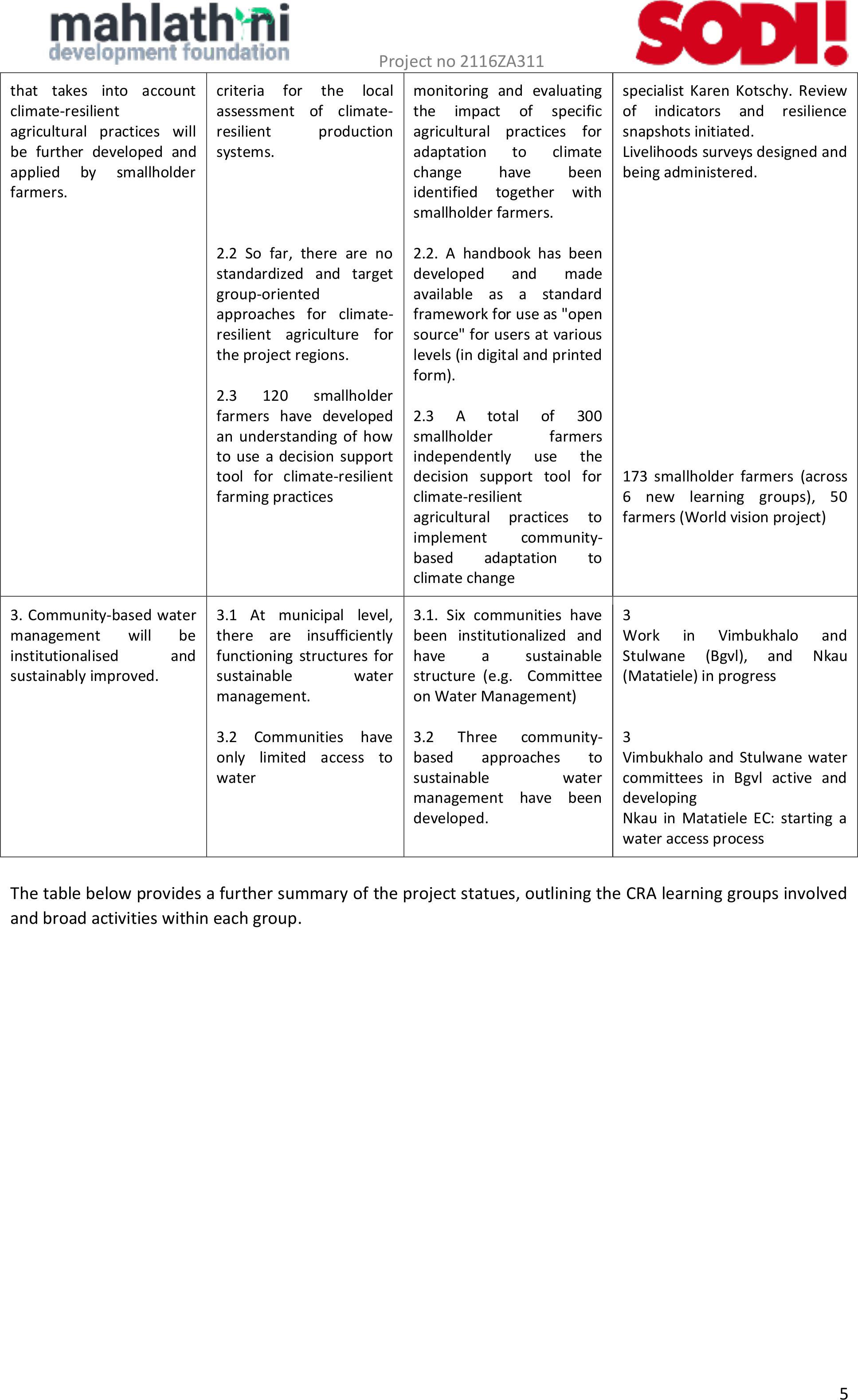
Project no 2116ZA311
5
that takes into account
climate-resilient
agricultural practices will
be further developed and
applied by smallholder
farmers.
criteria forthe local
assessment of climate-
resilient production
systems.
2.2 So far, there are no
standardized and target
group-oriented
approaches for climate-
resilient agriculture for
the project regions.
2.3 120 smallholder
farmers have developed
an understanding of how
to use a decision support
tool for climate-resilient
farming practices
monitoring and evaluating
the impact ofspecific
agricultural practices for
adaptation toclimate
change have been
identified together with
smallholder farmers.
2.2. A handbook has been
developed and made
available as a standard
framework for use as "open
source" for users at various
levels (in digital and printed
form).
2.3 A total of300
smallholder farmers
independently use the
decision support tool for
climate-resilient
agricultural practices to
implement community-
based adaptation to
climate change
specialist Karen Kotschy. Review
of indicators and resilience
snapshots initiated.
Livelihoods surveys designed and
being administered.
173smallholder farmers (across
6 new learning groups),50
farmers (World vision project)
3. Community-based water
management will be
institutionalised and
sustainably improved.
3.1 At municipal level,
there are insufficiently
functioning structures for
sustainable water
management.
3.2 Communitieshave
only limited access to
water
3.1. Six communities have
been institutionalized and
have a sustainable
structure (e.g. Committee
on Water Management)
3.2 Three community-
based approaches to
sustainable water
management have been
developed.
3
Work in Vimbukhalo and
Stulwane (Bgvl), and Nkau
(Matatiele) in progress
3
Vimbukhalo and Stulwane water
committees in Bgvl active and
developing
Nkau in Matatiele EC: starting a
water access process
The table below provides a further summary of the project statues, outlining the CRA learning groups involved
and broad activities within each group.
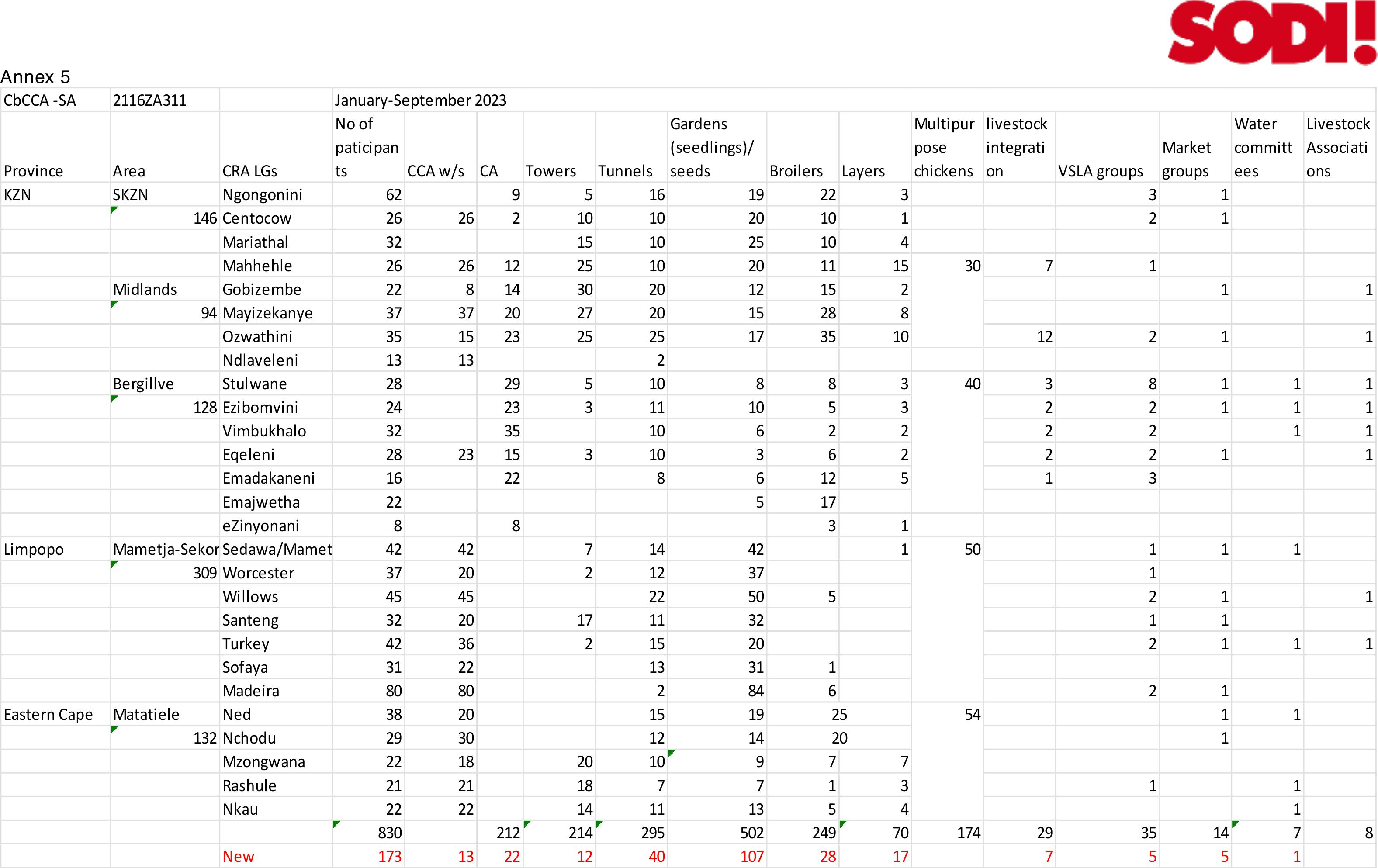
Annex 5
CbCCA -SA2116ZA311
ProvinceAreaCRA LGs
No of
paticipan
ts
CCA w/sCA Towers Tunnels
Gardens
(seedlings)/
seeds
Broilers Layers
Multipur
pose
chickens
livestock
integrati
on
VSLA groups
Market
groups
Water
committ
ees
Livestock
Associati
ons
KZNSKZN Ngongonini62 95 1619 2233 1
146 Centocow 2626 210 1020 1012 1
Mariathal 3215 1025 104
Mahhehle 26 2612 25 1020 11 157 1
Midlands Gobizembe22 8
14 30 2012 1521 1
94 Mayizekanye 37 37
20 27 2015 288
Ozwathini 35 15
23 25 2517 35 10122 11
Ndlaveleni 13 132
Bergillve Stulwane2829 510 8 8 338 1 1 1
128 Ezibomvini 2423 31110 5 322 1 1 1
Vimbukhalo 323510 6 2 2221 1
Eqeleni 2823 15310 3 6 222 11
Emadakaneni 16 2286 12 51 3
Emajwetha 22 517
eZinyonani883 1
Limpopo
Mametja-Sekororo
Sedawa/Mametja
42 42714 4211 1 1
309 Worcester 37 20212 371
Willows 45 45225052 11
Santeng 32 2017 11321 1
Turkey 42 36215 202 1 1 1
Sofaya 31 2213311
Madeira 80 80284 62 1
Eastern CapeMatatieleNed38 2015191 1
132 Nchodu 29 3012141
Mzongwana 22 1820 109 7 7
Rashule 21 211877 1 311
Nkau 22 2214 11135 41
830212 214 295502 24970 1742935147 8
New 173 1322 12 40107 28 1775 5 1
January-September 2023
25
20
30
40
50
54
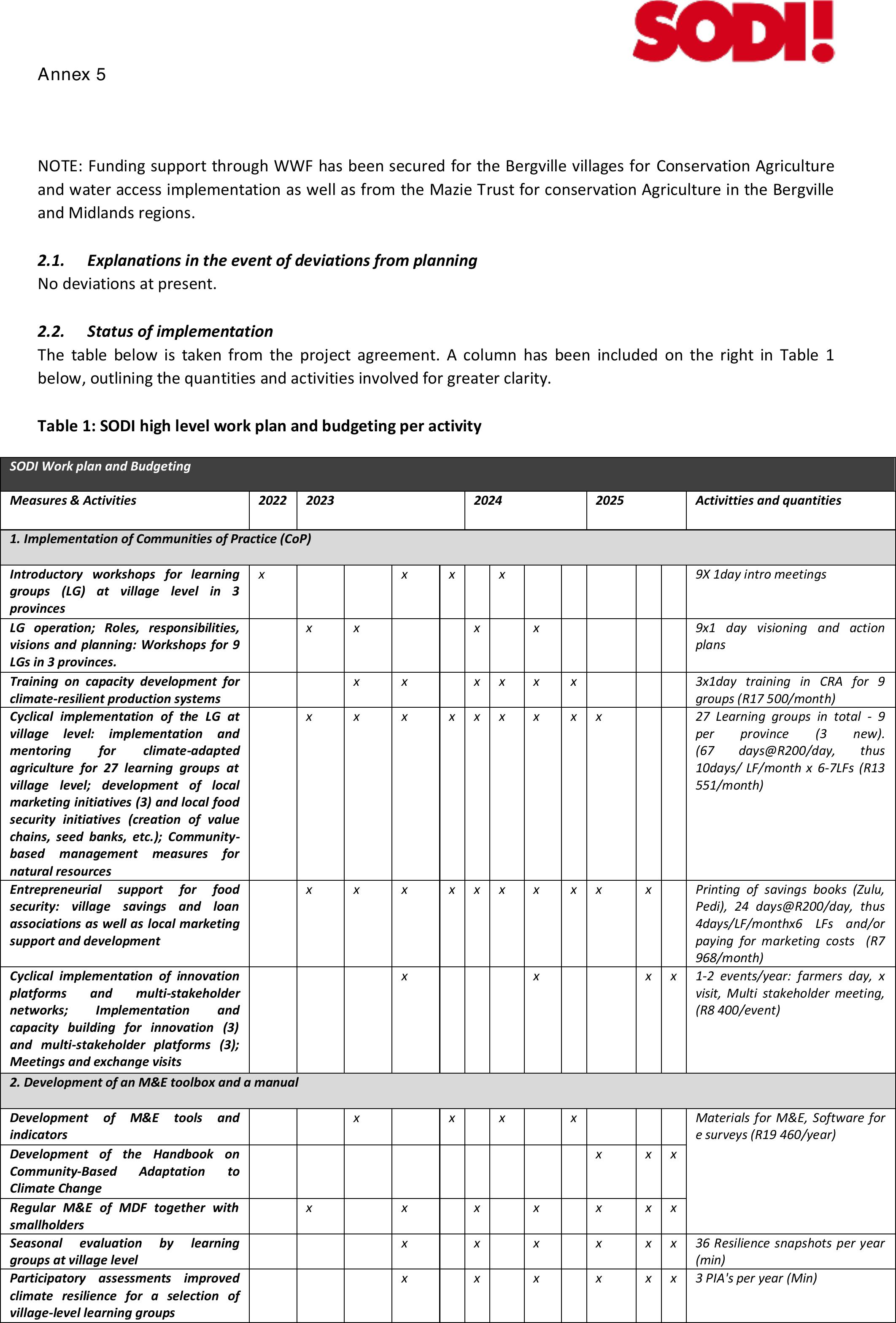
Annex 5
NOTE: Funding support through WWF has been secured for the Bergville villages for Conservation Agriculture
and water accessimplementation as well as from the Mazie Trust for conservation Agriculture in the Bergville
and Midlands regions.
2.1.Explanations in the event of deviations from planning
No deviations at present.
2.2.Status of implementation
The table below is taken from the project agreement. A column hasbeen included on the right in Table 1
below, outlining the quantities and activities involved for greater clarity.
Table 1: SODI high level work plan and budgeting per activity
SODI Work plan and Budgeting
Measures& Activities
2022
2023
2024
2025
Activitties and quantities
1. Implementation of Communities of Practice (CoP)
Introductory workshopsfor learning
groups (LG) at village level in 3
provinces
x
x
x
x
9X 1day intro meetings
LG operation; Roles, responsibilities,
visions and planning: Workshops for 9
LGs in 3 provinces.
x
x
x
x
9x1 day visioning andaction
plans
Training on capacity development for
climate-resilient production systems
x
x
x
x
x
x
3x1day training in CRA for 9
groups (R17 500/month)
Cyclical implementation of the LG at
village level: implementation and
mentoring for climate-adapted
agriculture for 27 learning groups at
village level; development of local
marketing initiatives (3) and local food
security initiatives (creation of value
chains, seed banks, etc.); Community-
based management measures for
natural resources
x
x
x
x
x
x
x
x
x
27 Learning groups in total - 9
per province (3 new).
(67 days@R200/day, thus
10days/ LF/monthx6-7LFs(R13
551/month)
Entrepreneurial support for food
security: village savings and loan
associations aswell as local marketing
support and development
x
x
x
x
x
x
x
x
x
x
Printing of savings books (Zulu,
Pedi), 24 days@R200/day, thus
4days/LF/monthx6 LFsand/or
paying for marketing costs (R7
968/month)
Cyclical implementation of innovation
platforms and multi-stakeholder
networks; Implementation and
capacity building for innovation (3)
and multi-stakeholder platforms (3);
Meetings and exchange visits
x
x
x
x
1-2 events/year: farmers day, x
visit, Multi stakeholder meeting,
(R8 400/event)
2. Development of an M&E toolbox and a manual
Development of M&E tools and
indicators
x
x
x
x
Materialsfor M&E, Software for
e surveys (R19 460/year)
Development of the Handbook on
Community-Based Adaptation to
Climate Change
x
x
x
Regular M&E of MDF together with
smallholders
x
x
x
x
x
x
x
Seasonal evaluation by learning
groups at village level
x
x
x
x
x
x
36 Resilience snapshots per year
(min)
Participatory assessments improved
climate resilience for a selection of
village-level learning groups
x
x
x
x
x
x
3 PIA's per year (Min)

Project no 2116ZA311
8
3. Sustainable water management
Establishment and implementation of
institutional structures such as water
management committees
x
x
x
x
x
x
x
x
x
x
Development of threeconcepts for
sustainable access to water
x
x
x
x
x
Investment
2022
2023
2024
Amount per person
Tunnels
R5 463,00
5
35
30
Poultry
R2 021,00
10
45
45
Seed (CA, veg) and poultry feed
R1 815,00
10
45
45
To further outline the activites, annual tragets and actuals have been outlined in Table 2.This table will be
updated quartely.
Table 2: Targets and actuals for project activities
Target
Actual
Target
Actual
Target
Actual
Target
Actual
2022
2022
2023
2023
2024
2024
2025
2025
No CCA Intro w/s
2
2
5
Eqeleni, eMadakaneni (Bgvl), Sofaya, Madeira (Limpopo),
Mzongwana (EC)
2
No CCA Planning
w/s
2
2
5
Eqeleni, eMadakaneni (Bgvl), Sofaya, Madeira (Limpopo),
Mzongwana (EC
2
Training days
(demos)
6
10
12
17 (EC), 4 (Bgvl), 4 (SKZN), & (Limpopo): Tower gardens,
mixed cropping, pestand disease control, trench beds, tunnel
construction, VLSLA’s value adding
12
No of LGs
18
23
23
25
27
27
No of participants -
monitoring
108
60(CA) + 107 (gardens) +55 (poultry)+ 65 livelihoods survey
108
108
Platforms (3 Ips, 3
Multi stakeholders)
2
2
6
3 lps, 3 multistakeholder (SANBI, AN, WWF),
- CA open days(multiple villages and areas, provincial CA forumand
National CA forum)
- Joint Livestock farmer’s day with KZNDARD, in Mayizekanye
(Midlands) and continuation ofjoint livestock associations learning
events
- Marketing review and planning (5 villages) Bergville
6
6
Cross visits
-1: Community level(10 Midlands farmersto Bgvl for CA open day –
March 23)
-1: Organisational (12 Wagenegin/UFS students to Bgvlfor Land
dynamics course)
-1: CRA farmers and restoration teams under INR, cross visit to Bgvl
(April 2023)
-1: Amazizi and Amangwane Developmentcommittees cross visit to
Stulwane re CRA implementation and water access (27th Sept 2023)
-1: Ezibovmini cross visit to Stulwane re community-based resource
management planning and implementation (29th Sept 2023)
No CCA
prioritization
planning sessions
2
8
3(Bgvl-Eqeleni, eMadakaneni, eMahlathini), 5 (Limpopo-Sofaya,
Madeira, Willows, Sedawa, Turkey),
8
18
No CCA review
sessions
2
12
8
5 CA review sessions in Bgvl (Stulwane, Ezibomvini, Vimbukhalo,
Emajwetha, EMadakaneni)
8
18
No CCA re-planning
sessions
2
12
8
5(EC-Ned, Nchodu, Nkau, Rashule, Mzongwana), 2 (Midlands-
Mayizekanye, Gobizembe)
8
18
VSLAs (360
participants,18
VSLAS)
18
38
18
18
Water access
scenarios (min 2)
1
4 (Vimbukhalo, Stulwane, Ezibomvini, Nkau)
1
1
Livestock
1
1
1
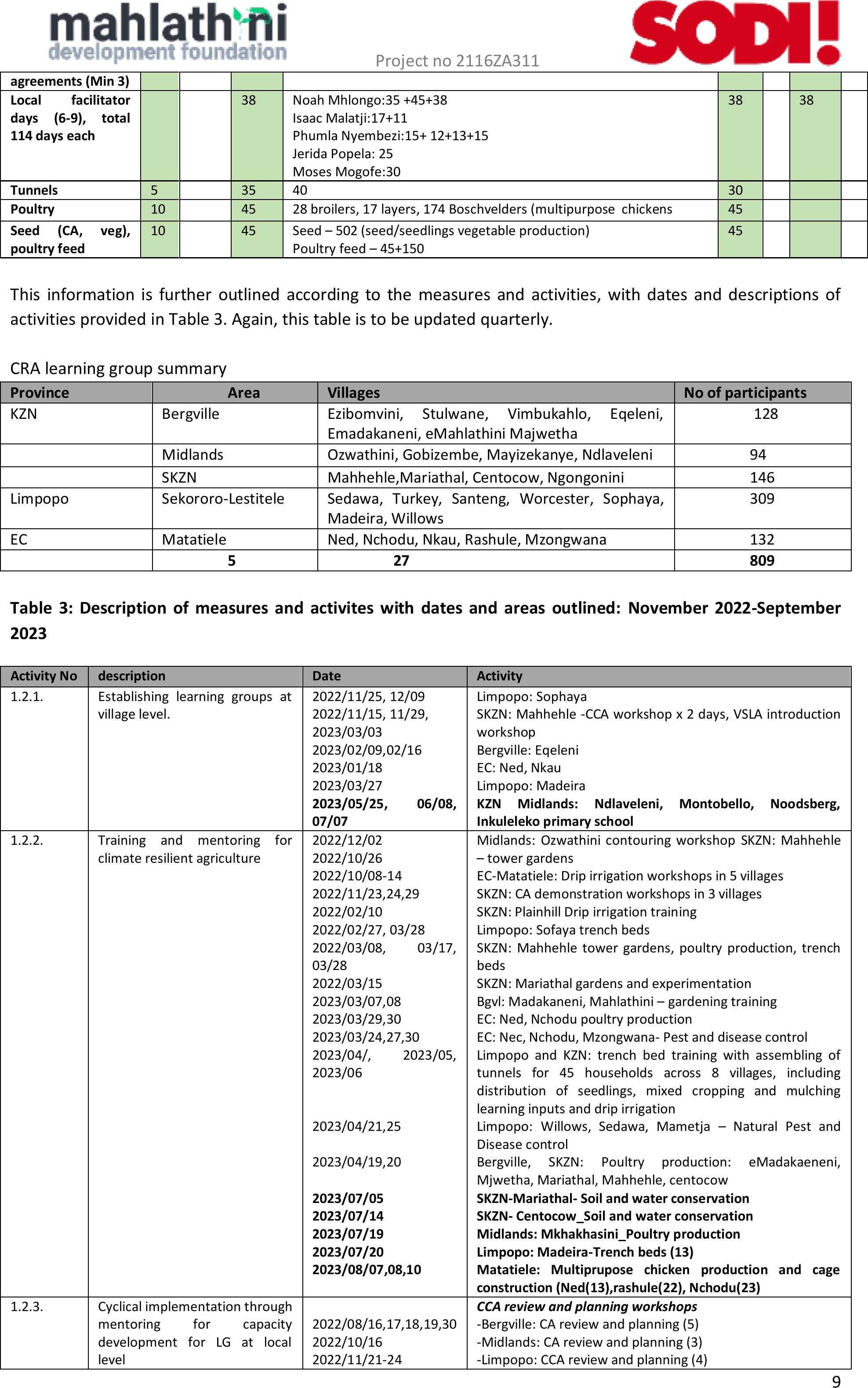
Project no 2116ZA311
9
agreements (Min 3)
Local facilitator
days (6-9), total
114 days each
38
Noah Mhlongo:35 +45+38
Isaac Malatji:17+11
Phumla Nyembezi:15+ 12+13+15
Jerida Popela: 25
Moses Mogofe:30
38
38
Tunnels
5
35
40
30
Poultry
10
45
28 broilers, 17 layers, 174 Boschvelders (multipurpose chickens
45
Seed (CA, veg),
poultry feed
10
45
Seed –502 (seed/seedlings vegetable production)
Poultry feed – 45+150
45
This information is further outlined according to the measuresand activities, with dates and descriptions of
activities provided in Table 3. Again, this table is to be updated quarterly.
CRA learning group summary
Province
Area
Villages
No of participants
KZN
Bergville
Ezibomvini, Stulwane, Vimbukahlo, Eqeleni,
Emadakaneni, eMahlathini Majwetha
128
Midlands
Ozwathini, Gobizembe, Mayizekanye, Ndlaveleni
94
SKZN
Mahhehle,Mariathal, Centocow, Ngongonini
146
Limpopo
Sekororo-Lestitele
Sedawa, Turkey, Santeng, Worcester, Sophaya,
Madeira, Willows
309
EC
Matatiele
Ned, Nchodu, Nkau, Rashule, Mzongwana
132
5
27
809
Table 3: Descriptionof measures andactivites with dates and areas outlined: November 2022-September
2023
Activity No
description
Date
Activity
1.2.1.
Establishing learning groupsat
village level.
2022/11/25, 12/09
2022/11/15, 11/29,
2023/03/03
2023/02/09,02/16
2023/01/18
2023/03/27
2023/05/25, 06/08,
07/07
Limpopo: Sophaya
SKZN:Mahhehle -CCA workshop x 2 days, VSLA introduction
workshop
Bergville: Eqeleni
EC: Ned, Nkau
Limpopo: Madeira
KZN Midlands: Ndlaveleni, Montobello, Noodsberg,
Inkuleleko primary school
1.2.2.
Training and mentoring for
climate resilient agriculture
2022/12/02
2022/10/26
2022/10/08-14
2022/11/23,24,29
2022/02/10
2022/02/27, 03/28
2022/03/08, 03/17,
03/28
2022/03/15
2023/03/07,08
2023/03/29,30
2023/03/24,27,30
2023/04/, 2023/05,
2023/06
2023/04/21,25
2023/04/19,20
2023/07/05
2023/07/14
2023/07/19
2023/07/20
2023/08/07,08,10
Midlands: Ozwathini contouring workshopSKZN:Mahhehle
– tower gardens
EC-Matatiele: Drip irrigation workshops in 5 villages
SKZN: CA demonstration workshops in 3 villages
SKZN:Plainhill Drip irrigation training
Limpopo: Sofaya trench beds
SKZN:Mahhehle tower gardens, poultry production, trench
beds
SKZN: Mariathal gardens and experimentation
Bgvl: Madakaneni, Mahlathini – gardening training
EC: Ned, Nchodu poultry production
EC: Nec, Nchodu, Mzongwana- Pest and disease control
Limpopo and KZN: trench bed training with assembling of
tunnels for 45 households across 8 villages, including
distribution of seedlings, mixed cropping and mulching
learning inputs and drip irrigation
Limpopo: Willows, Sedawa, Mametja –NaturalPestand
Disease control
Bergville, SKZN:Poultry production: eMadakaeneni,
Mjwetha, Mariathal, Mahhehle, centocow
SKZN-Mariathal- Soil and water conservation
SKZN- Centocow_Soil and water conservation
Midlands: Mkhakhasini_Poultry production
Limpopo: Madeira-Trench beds (13)
Matatiele: Multiprupose chicken production andcage
construction (Ned(13),rashule(22), Nchodu(23)
1.2.3.
Cyclical implementation through
mentoring for capacity
development for LG at local
level
2022/08/16,17,18,19,30
2022/10/16
2022/11/21-24
CCA review and planning workshops
-Bergville: CA review and planning (5)
-Midlands: CA review and planning (3)
-Limpopo: CCA review and planning (4)

Project no 2116ZA311
10
Incl: CCA workshops ,reviews
and replanning
2023/01/24-30
2023/04/24-26
2023/06
2023/07/10
2023/07/19
CCA prioritization of practices
-Matatiele: 5 villages (Ned, Nchodu, Rahsule, Nkau,
Mzongwana
-Limpopo: Worcester, Willows, Mametja five fingerreviews
and planning
Midlands; CCAworkshops- Ozwathini, Mayizekanye,
Gobizembe/Ndlaveleni
Mkhakhasini-Ozwathini: Review and expansionofexisting
group (21)
Limpopo: Mametja-Bosholozi: CCA introduction and
prioritization of practices (20)
1.2.4.
Income diversification and
economicempowerment of
local farmers (LG at local level)
2022/10/02,11/03,
12/04, 2023/02/02,
03/02, 04/02, 05/08,
06/05
2022/10/08,11/07,
12/02, 02/03, 03/03,
04/03, 05/02, 06/02,
07/04
2022/11/05,06,07,
12/13, 2023/01/27,
02/07, 07/04, 08/05,
09/05
2023/06/02, 07/07
2023/06/03, 07/01
2023/01/26
2023/02/14
2023/06/01, 06/28
July-Sept 2023
July-Sept 2023
Market days: monthly farmers markets
-Midlands: Bamshela (Ozwathini)
-SKZN: Creighton (Centocow)
- Bergville: Bergville town
-Wartburg farmers Market (Gobizembe)
-Hoedspruit farmers’ Market (Tala Table Network)
Market exploration workshops
-Midlands: Mayizekanye, Gobizembe
-PGS follow-up w/s Limpopo
-EC_Ned-Nchodu market day in Matatiele
-SKZN: Mariathal
-Limpopo: Mametja-Sekororo PGS –committee and
assessments
VSLAs
VSLA meetings and share outs
-Bergvile: 9
-SKZN: Ngongonini (3), Centocow (2)
-Midlands: Ozwathini (2)
Limpopo: (7)
-Livelihoods survey– all areas
1.2.5.
Implementation and capacity
development for innovation (3)
and multi-stakeholder platforms
(3)
2022/11/18
2022/11/10
2022/12/01
2023/02/23
2023/02/28
2023/03/08,09
2023/03/28,29
2023/03/30, 06/02
2023/04/26
2023/05/09
2023/06/04
2023/08/07,08
2023/08/08
2023/08/14
2023/08/29
2023/08/30
2023/09/04
2023/09/08
2023/09/13
2023/09/22-24
-SKZN: Centocow P&D control cross visit and learning
workshop
-uThukela water source forum: Visioning and action planning
– Bergville
-Adaptation Network AGM
-Regenerative Agric farmers’ day in Bergville incl Asset
research, uThukela Water Source Forum, uThukela
Development Agency
-Adaptation Network: CCA financing dialogue
-SANBI_gender mainstreaming dialogue
-WRC-ESS: Bglv Ezibomvini, Stulwane –resource
management mapping and planning
-Okahlamba LED forum
-Farmers X visit between Bulwer (supported by the INR0 and
Bergville around CRA, fodder and restoration
-PGS-SA: market training input: Online training Session 5
SANBI Newsletter-CA implementation for adaptation
STI training in Hammanskraal: (3 days – CCA, CRA, nutrition,
value adding
-Cedara field day and seminar on cover crops (30farmers
and field staff)
-Giyani Climate resilience project: Input into WRC reference
group meeting
-KZN DARD_ Farmers’ display at Bergville event
ACDI: Dialogue on community adaptation and resilience
(Stellenbosch)
Food systems article for newsletter
WWF-Business Network meeting (SAPPI Durban)-
presentation
Joint Bergville learning group localmarketing review
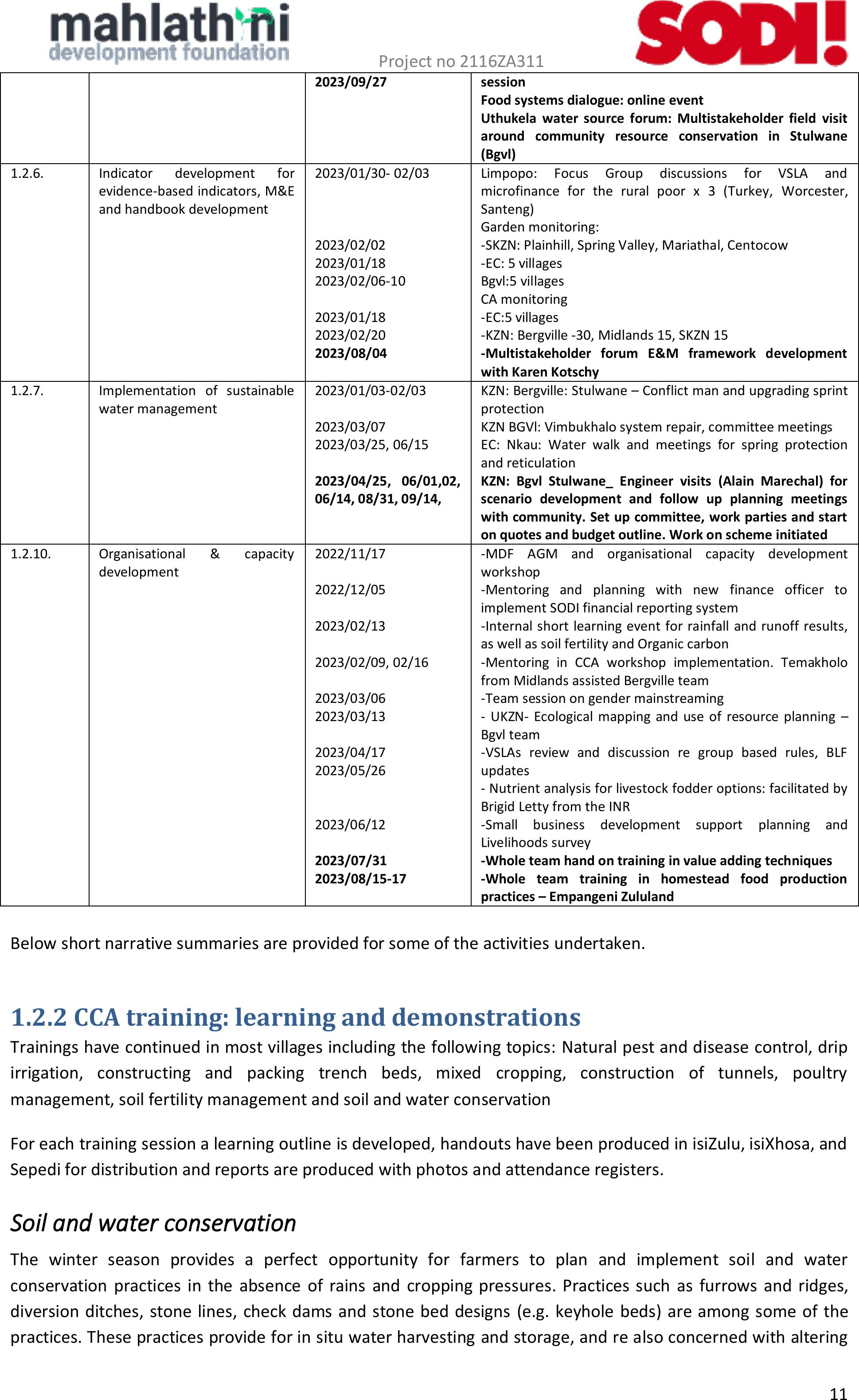
Project no 2116ZA311
11
2023/09/27
session
Food systems dialogue: online event
Uthukela water source forum: Multistakeholder fieldvisit
around community resource conservation in Stulwane
(Bgvl)
1.2.6.
Indicator development for
evidence-basedindicators, M&E
and handbook development
2023/01/30- 02/03
2023/02/02
2023/01/18
2023/02/06-10
2023/01/18
2023/02/20
2023/08/04
Limpopo: Focus Group discussions for VSLA and
microfinance for the ruralpoor x3 (Turkey, Worcester,
Santeng)
Garden monitoring:
-SKZN: Plainhill, Spring Valley, Mariathal, Centocow
-EC: 5 villages
Bgvl:5 villages
CA monitoring
-EC:5 villages
-KZN: Bergville -30, Midlands 15, SKZN 15
-Multistakeholderforum E&M framework development
with Karen Kotschy
1.2.7.
Implementation of sustainable
water management
2023/01/03-02/03
2023/03/07
2023/03/25, 06/15
2023/04/25, 06/01,02,
06/14, 08/31, 09/14,
KZN: Bergville: Stulwane – Conflict man and upgrading sprint
protection
KZN BGVl: Vimbukhalo system repair, committee meetings
EC: Nkau: Water walk and meetings for spring protection
and reticulation
KZN: Bgvl Stulwane_ Engineer visits (Alain Marechal) for
scenario development and follow up planning meetings
with community. Setup committee, work parties and start
on quotes and budget outline. Work on scheme initiated
1.2.10.
Organisational& capacity
development
2022/11/17
2022/12/05
2023/02/13
2023/02/09, 02/16
2023/03/06
2023/03/13
2023/04/17
2023/05/26
2023/06/12
2023/07/31
2023/08/15-17
-MDF AGM and organisational capacity development
workshop
-Mentoring and planning with newfinance officer to
implement SODI financial reporting system
-Internal short learning event for rainfall and runoff results,
as well as soil fertility and Organic carbon
-Mentoring in CCA workshop implementation. Temakholo
from Midlands assisted Bergville team
-Team session on gender mainstreaming
- UKZN- Ecological mapping and use of resource planning –
Bgvl team
-VSLAs review and discussion re group basedrules, BLF
updates
- Nutrient analysis for livestock fodder options: facilitated by
Brigid Letty from the INR
-Small business development support planning and
Livelihoods survey
-Whole team hand on training in value adding techniques
-Whole team training in homestead food production
practices – Empangeni Zululand
Below short narrative summaries are provided for some of the activities undertaken.
1.2.2 CCA training: learning and demonstrations
Trainings have continued in most villages including the following topics:Natural pest and disease control, drip
irrigation, constructing and packing trench beds, mixed cropping, construction of tunnels, poultry
management, soil fertility management and soil and water conservation
For each training session a learning outline is developed, handouts have been produced in isiZulu, isiXhosa, and
Sepedi for distribution and reports are produced with photos and attendance registers.
Soil and water conservation
The winter season provides a perfect opportunity forfarmers to plan and implement soil and water
conservation practices in the absence of rains and cropping pressures. Practices such as furrows and ridges,
diversion ditches, stone lines, check dams and stone bed designs (e.g. keyhole beds) areamong some of the
practices. These practices provide for in situ water harvesting and storage, and re also concerned with altering
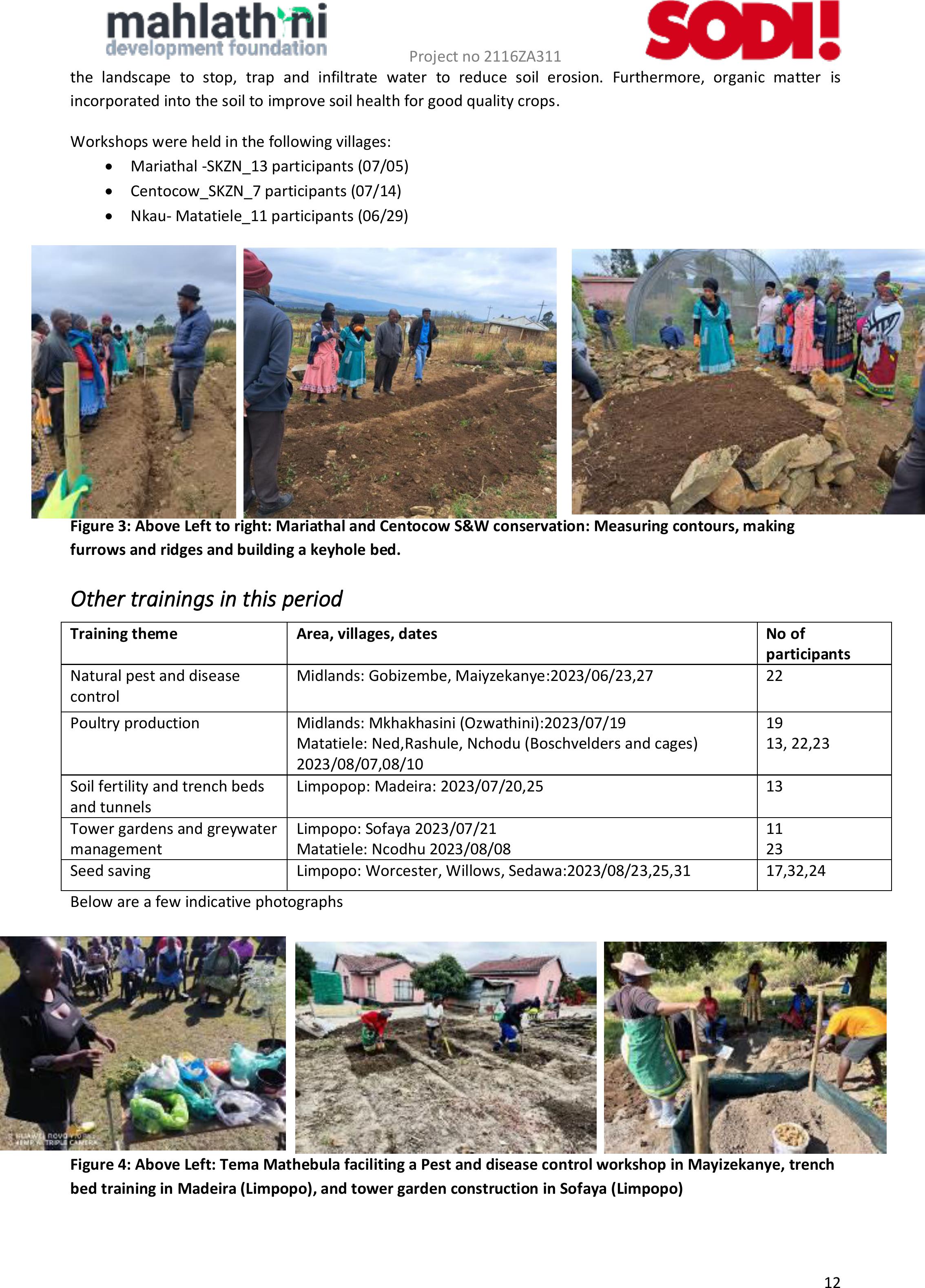
Project no 2116ZA311
12
the landscape to stop, trap and infiltratewater to reduce soil erosion. Furthermore, organic matter is
incorporated into the soil to improve soil health for good quality crops.
Workshops were held in the following villages:
•Mariathal -SKZN_13 participants (07/05)
•Centocow_SKZN_7 participants (07/14)
•Nkau- Matatiele_11 participants (06/29)
Figure 3: Above Left to right: Mariathal and Centocow S&W conservation: Measuring contours, making
furrows and ridges and building a keyhole bed.
Other trainings in this period
Training theme
Area, villages, dates
No of
participants
Natural pest and disease
control
Midlands: Gobizembe, Maiyzekanye:2023/06/23,27
22
Poultry production
Midlands: Mkhakhasini (Ozwathini):2023/07/19
Matatiele: Ned,Rashule, Nchodu (Boschvelders and cages)
2023/08/07,08/10
19
13, 22,23
Soil fertility and trench beds
and tunnels
Limpopop: Madeira: 2023/07/20,25
13
Tower gardens and greywater
management
Limpopo: Sofaya 2023/07/21
Matatiele: Ncodhu 2023/08/08
11
23
Seed saving
Limpopo: Worcester, Willows, Sedawa:2023/08/23,25,31
17,32,24
Below are a few indicative photographs
Figure 4: Above Left: Tema Mathebula faciliting a Pest and disease control workshop in Mayizekanye, trench
bed training in Madeira (Limpopo), and tower garden construction in Sofaya (Limpopo)
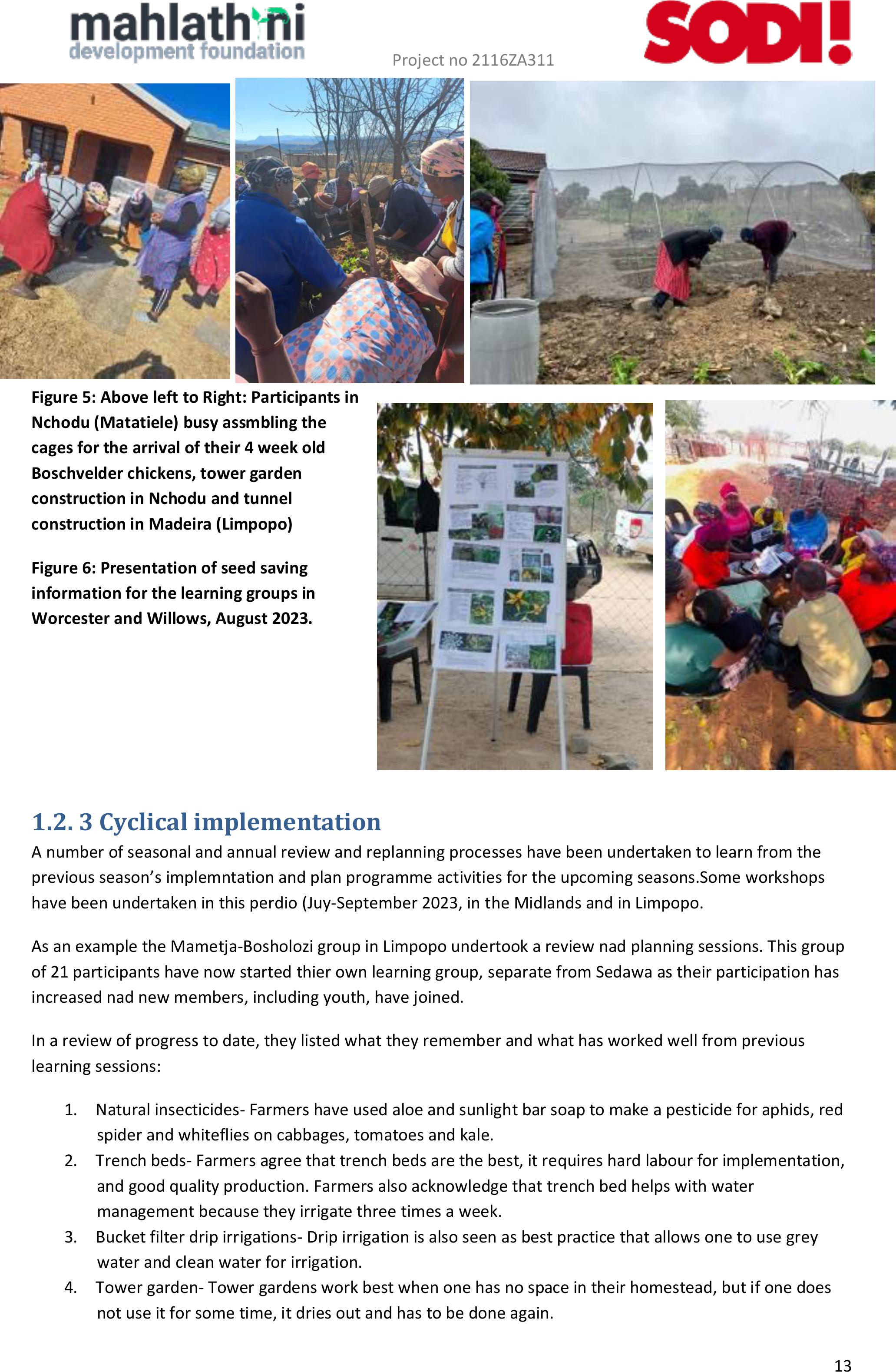
Project no 2116ZA311
13
Figure 5: Above left to Right: Participants in
Nchodu(Matatiele) busy assmbling the
cages for the arrival of their 4 week old
Boschvelder chickens, tower garden
construction in Nchodu and tunnel
construction in Madeira (Limpopo)
Figure 6: Presentationof seed saving
informationfor the learning groups in
Worcester and Willows, August 2023.
1.2. 3 Cyclical implementation
A number of seasonal and annual review and replanning processes have been undertaken to learn from the
previous season’s implemntation and plan programme activities for the upcoming seasons.Some workshops
have been undertaken in this perdio (Juy-September 2023, in the Midlands and in Limpopo.
As an example the Mametja-Bosholozi group in Limpopo undertook a review nad planning sessions. This group
of 21 participants have now started thier own learning group, separate from Sedawa as their participation has
increased nad new members, including youth, have joined.
In a review of progress to date, they listed what they remember and what has worked well from previous
learning sessions:
1.Natural insecticides- Farmers have used aloe and sunlight bar soap to make a pesticide for aphids, red
spider and whiteflies on cabbages, tomatoes and kale.
2.Trench beds- Farmers agree that trench beds are the best, it requires hard labour for implementation,
and good quality production. Farmers also acknowledge that trench bed helps with water
management because they irrigate three times a week.
3.Bucket filter drip irrigations- Drip irrigation is also seen as best practice that allows one to use grey
water and clean water for irrigation.
4.Tower garden- Tower gardens work best when one has no space in their homestead, but if one does
not use it for some time, it dries out and has to be done again.
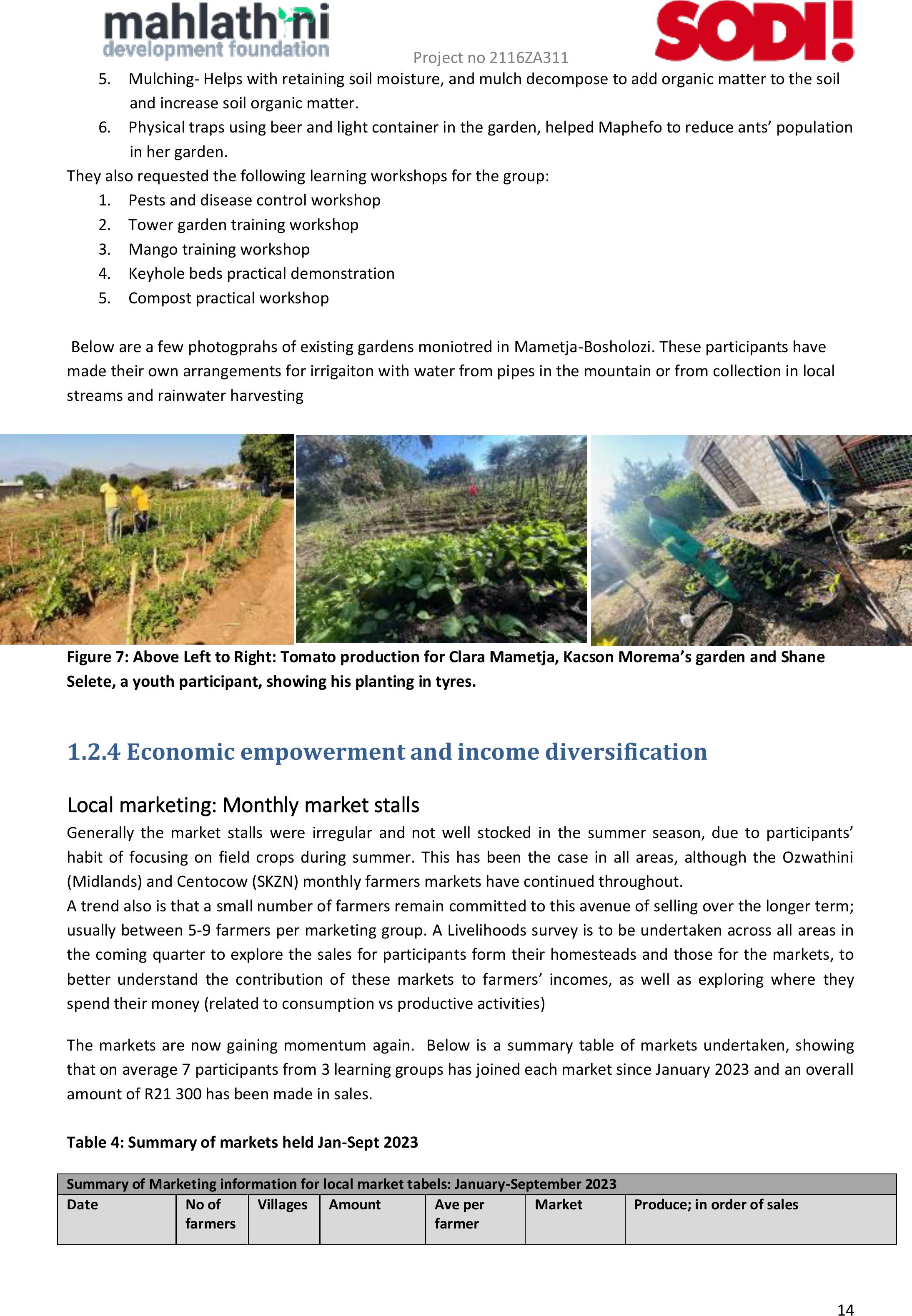
Project no 2116ZA311
14
5.Mulching- Helps with retaining soil moisture, and mulch decompose to add organic matter to the soil
and increase soil organic matter.
6.Physical traps using beer and light container in the garden, helped Maphefo to reduce ants’ population
in her garden.
They also requested the following learning workshops for the group:
1.Pests and disease control workshop
2.Tower garden training workshop
3.Mango training workshop
4.Keyhole beds practical demonstration
5.Compost practical workshop
Below are a few photogprahs of existing gardens moniotred in Mametja-Bosholozi. These participants have
made their own arrangements for irrigaiton with water from pipes in the mountain or from collection in local
streams and rainwater harvesting
Figure 7: Above Left toRight: Tomato production for Clara Mametja, Kacson Morema’s garden and Shane
Selete, a youth participant, showing his planting in tyres.
1.2.4 Economic empowerment and income diversification
Local marketing: Monthly market stalls
Generally the market stalls were irregular and not well stocked in the summerseason,due to participants’
habit of focusing on field crops during summer. This hasbeen the case in all areas, although the Ozwathini
(Midlands) and Centocow (SKZN) monthly farmers markets have continued throughout.
A trend also is that a small number of farmers remain committed to this avenue of selling over the longer term;
usually between 5-9farmers per marketing group.A Livelihoods survey is to be undertaken across all areas in
the coming quarter to explore the sales for participants form their homesteads and those for the markets, to
better understandthecontribution of these markets to farmers’ incomes, as well as exploring where they
spend their money (related to consumption vs productive activities)
The markets are nowgaining momentum again. Below is a summary table ofmarkets undertaken, showing
that on average 7 participants from 3 learning groups has joined each market since January 2023 and an overall
amount of R21 300 has been made in sales.
Table 4: Summary of markets held Jan-Sept 2023
Summary of Marketing information for local market tabels: January-September 2023
Date
No of
farmers
Villages
Amount
Ave per
farmer
Market
Produce; in order of sales
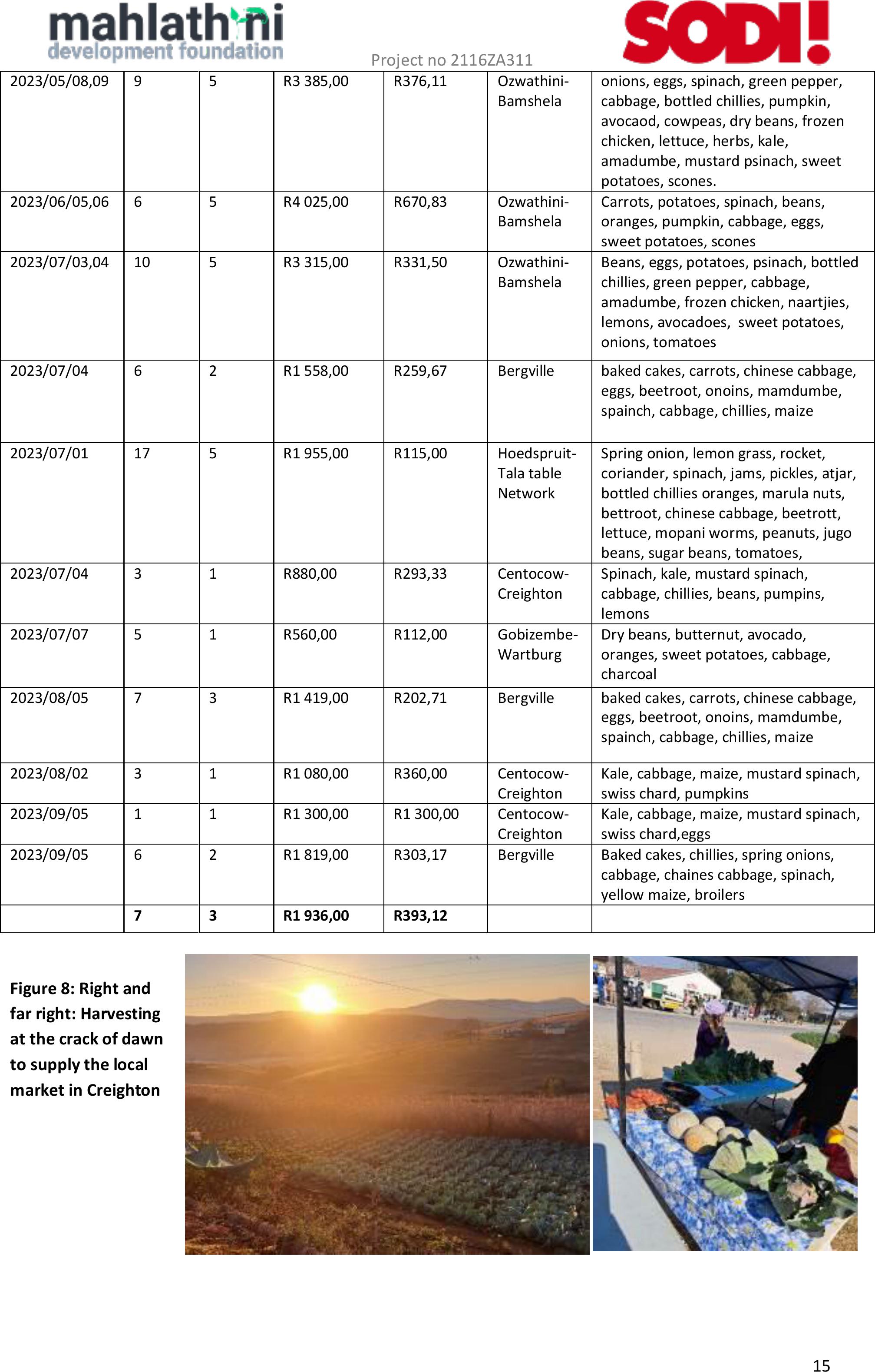
Project no 2116ZA311
15
2023/05/08,09
9
5
R3 385,00
R376,11
Ozwathini-
Bamshela
onions, eggs, spinach, green pepper,
cabbage, bottled chillies, pumpkin,
avocaod, cowpeas, dry beans, frozen
chicken, lettuce, herbs, kale,
amadumbe, mustard psinach, sweet
potatoes, scones.
2023/06/05,06
6
5
R4 025,00
R670,83
Ozwathini-
Bamshela
Carrots, potatoes, spinach, beans,
oranges, pumpkin, cabbage, eggs,
sweet potatoes, scones
2023/07/03,04
10
5
R3 315,00
R331,50
Ozwathini-
Bamshela
Beans, eggs, potatoes, psinach, bottled
chillies, green pepper, cabbage,
amadumbe, frozen chicken, naartjies,
lemons, avocadoes, sweet potatoes,
onions, tomatoes
2023/07/04
6
2
R1 558,00
R259,67
Bergville
baked cakes, carrots, chinese cabbage,
eggs, beetroot, onoins, mamdumbe,
spainch, cabbage, chillies, maize
2023/07/01
17
5
R1 955,00
R115,00
Hoedspruit-
Tala table
Network
Spring onion, lemon grass, rocket,
coriander, spinach, jams, pickles, atjar,
bottled chillies oranges, marula nuts,
bettroot, chinese cabbage, beetrott,
lettuce, mopani worms, peanuts, jugo
beans, sugar beans, tomatoes,
2023/07/04
3
1
R880,00
R293,33
Centocow-
Creighton
Spinach, kale, mustard spinach,
cabbage, chillies, beans, pumpins,
lemons
2023/07/07
5
1
R560,00
R112,00
Gobizembe-
Wartburg
Dry beans, butternut, avocado,
oranges, sweet potatoes, cabbage,
charcoal
2023/08/05
7
3
R1 419,00
R202,71
Bergville
baked cakes, carrots, chinese cabbage,
eggs, beetroot, onoins, mamdumbe,
spainch, cabbage, chillies, maize
2023/08/02
3
1
R1 080,00
R360,00
Centocow-
Creighton
Kale, cabbage, maize, mustard spinach,
swiss chard, pumpkins
2023/09/05
1
1
R1 300,00
R1 300,00
Centocow-
Creighton
Kale, cabbage, maize, mustard spinach,
swiss chard,eggs
2023/09/05
6
2
R1 819,00
R303,17
Bergville
Baked cakes, chillies, spring onions,
cabbage, chaines cabbage, spinach,
yellow maize, broilers
7
3
R1 936,00
R393,12
Figure 8: Right and
far right: Harvesting
at the crack of dawn
to supply the local
market in Creighton
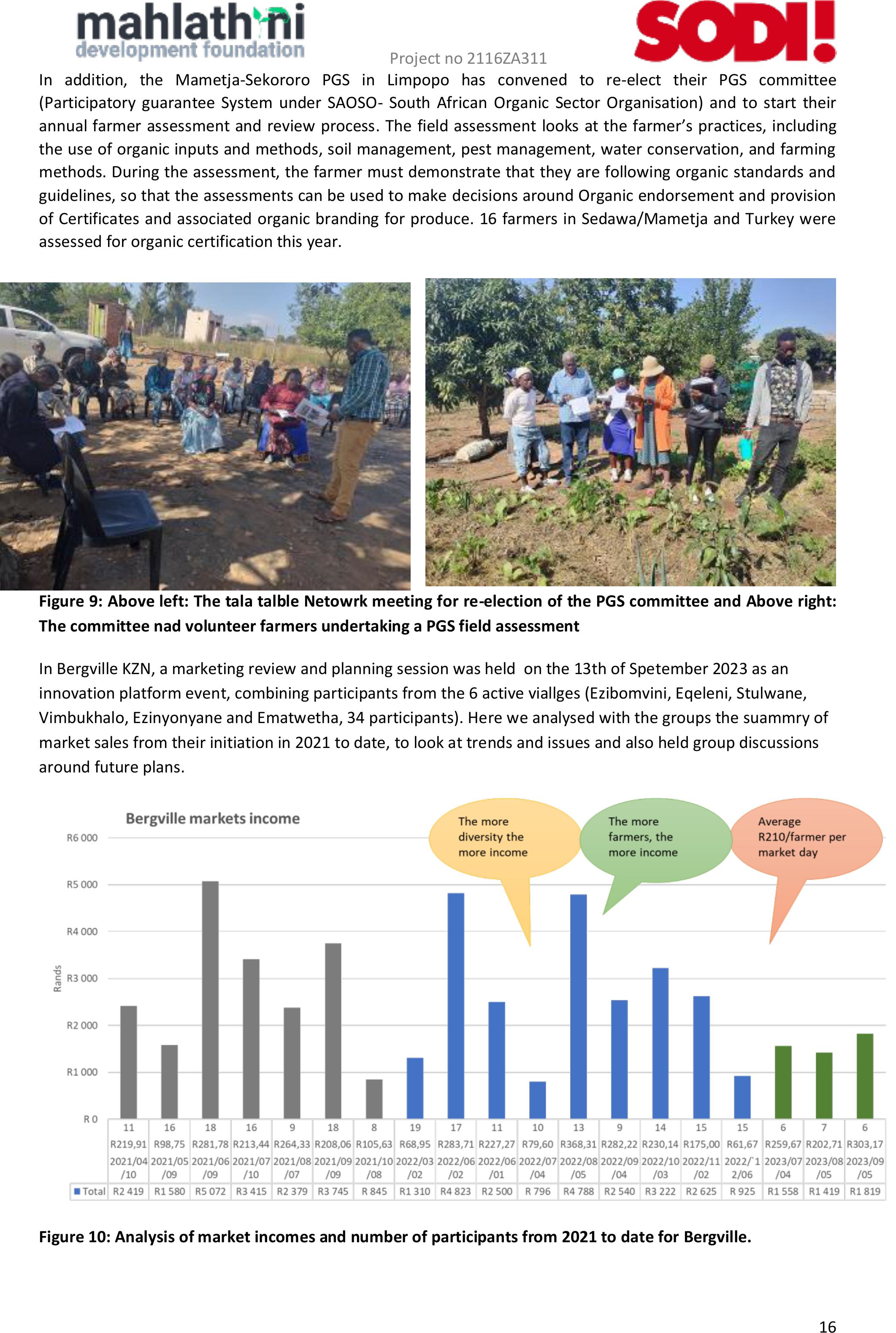
Project no 2116ZA311
16
In addition, the Mametja-SekororoPGS in Limpopo has convened to re-elect their PGScommittee
(Participatory guarantee System under SAOSO- South African Organic Sector Organisation) and to start their
annual farmer assessment and review process. The field assessment looks at the farmer’spractices, including
the use of organic inputs and methods, soil management, pest management, water conservation, and farming
methods. During the assessment, the farmer must demonstrate that they are following organic standards and
guidelines, so that the assessments can be used to make decisions around Organic endorsement and provision
of Certificates and associated organic branding for produce. 16 farmers in Sedawa/Mametja and Turkey were
assessed for organic certification this year.
Figure 9: Above left: The tala talble Netowrk meeting for re-election of the PGS committee and Above right:
The committee nad volunteer farmers undertaking a PGS field assessment
In Bergville KZN, a marketing review and planning session washeld on the 13th of Spetember 2023 as an
innovation platform event, combining participants from the 6 active viallges (Ezibomvini, Eqeleni, Stulwane,
Vimbukhalo, Ezinyonyane and Ematwetha, 34 participants). Here we analysed with the groups the suammry of
market sales from their initiation in 2021 to date, to look at trends and issues and also held group discussions
around future plans.
Figure 10: Analysis of market incomes and number of participants from 2021 to date for Bergville.
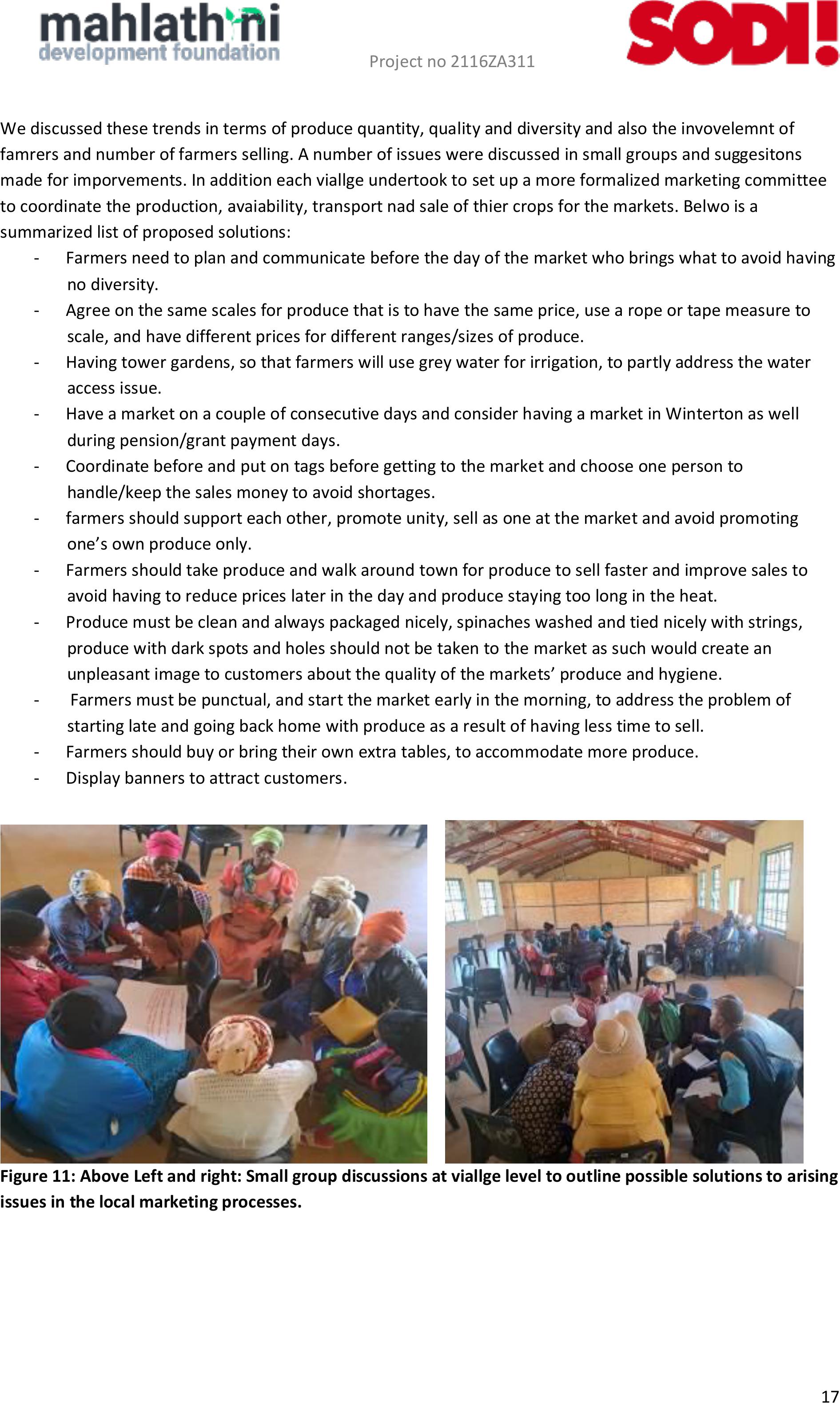
Project no 2116ZA311
17
We discussed these trends in terms of produce quantity, quality and diversity and also the invovelemnt of
famrers and number of farmers selling. A number of issues were discussed in small groups and suggesitons
made for imporvements. In addition each viallge undertook to set up a more formalized marketing committee
to coordinate the production, avaiability, transport nad sale of thier crops for the markets. Belwo is a
summarized list of proposed solutions:
-Farmers need to plan and communicate before the day of the market who brings what to avoid having
no diversity.
-Agree on the same scales for produce that is to have the same price, use a rope or tape measure to
scale, and have different prices for different ranges/sizes of produce.
-Having tower gardens, so that farmers will use grey water for irrigation, to partly address the water
access issue.
-Have a market on a couple of consecutive days and consider having a market in Winterton as well
during pension/grant payment days.
-Coordinate before and put on tags before getting to the market and choose one person to
handle/keep the sales money to avoid shortages.
-farmers should support each other, promote unity, sell as one at the market and avoid promoting
one’s own produce only.
-Farmers should take produce and walk around town for produce to sell faster and improve sales to
avoid having to reduce prices later in the day and produce staying too long in the heat.
-Produce must be clean and always packaged nicely, spinaches washed and tied nicely with strings,
produce with dark spots and holes should not be taken to the market as such would create an
unpleasant image to customers about the quality of the markets’ produce and hygiene.
- Farmers must be punctual, and start the market early in the morning, to address the problem of
starting late and going back home with produce as a result of having less time to sell.
-Farmers should buy or bring their own extra tables, to accommodate more produce.
-Display banners to attract customers.
Figure 11: Above Left and right: Small group discussions at viallge level to outline possible solutions to arising
issues in the local marketing processes.
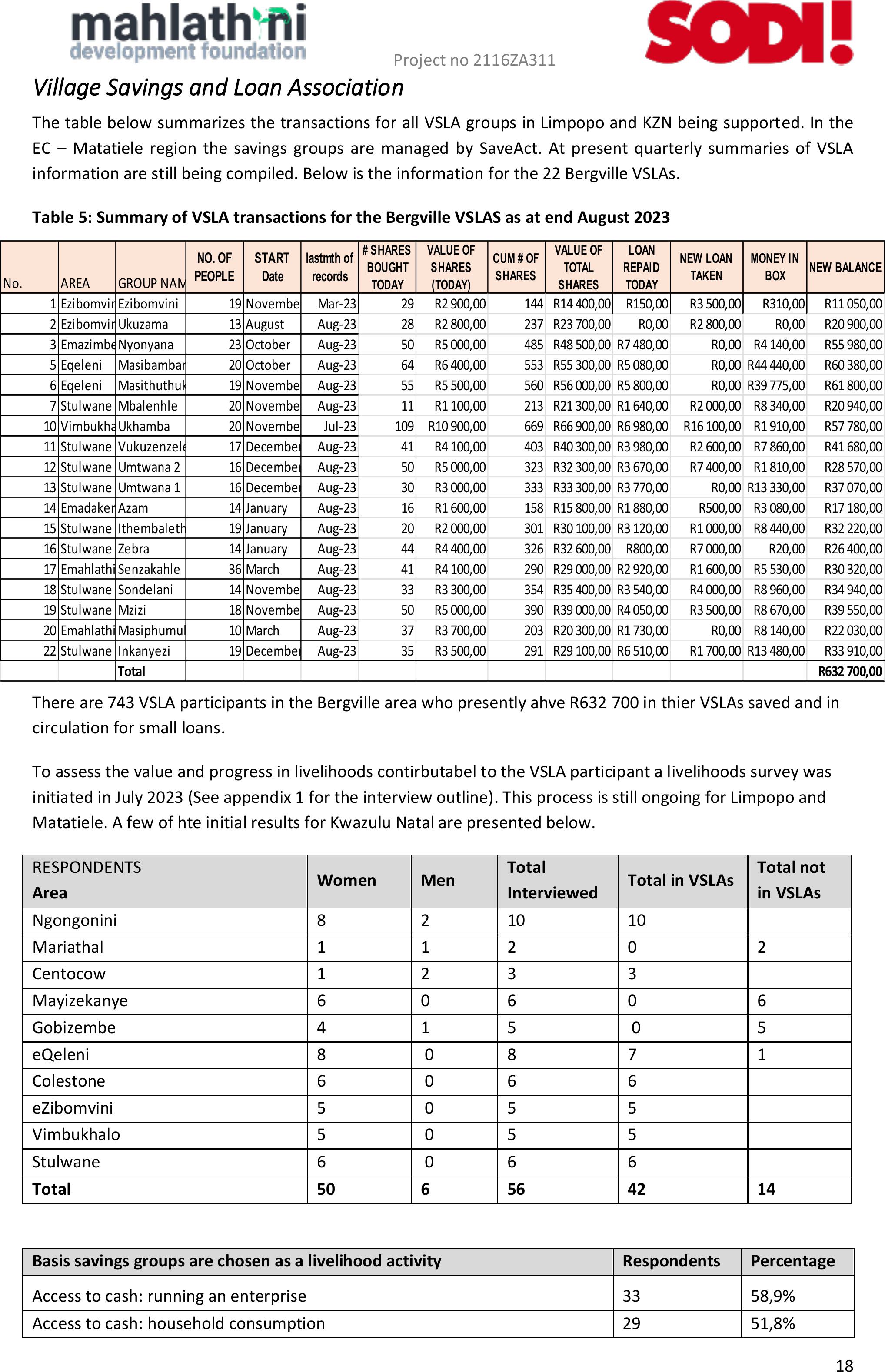
Project no 2116ZA311
18
No. AREA
GROUPNAME
NO. OF
PEOPLE
START
Date
lastmth of
records
# SHARES
BOUGHT
TODAY
VALUE OF
SHARES
(TODAY)
CUM # OF
SHARES
VALUE OF
TOTAL
SHARES
LOAN
REPAID
TODAY
NEW LOAN
TAKEN
MONEY IN
BOX
NEW BALANCE
1
Ezibomvini
Ezibomvini 19
November
Mar-23 29 R2 900,00144 R14 400,00R150,00R3 500,00R310,00R11 050,00
2
Ezibomvini
Ukuzama 13 August Aug-2328 R2 800,00237 R23 700,00R0,00R2 800,00R0,00R20900,00
3
Emazimbeni
Nyonyana 23 October Aug-2350 R5 000,00485 R48 500,00R7480,00R0,00R4 140,00R55 980,00
5 Eqeleni
Masibambane
20 October Aug-2364 R6 400,00553 R55 300,00R5 080,00R0,00R44 440,00R60 380,00
6 Eqeleni
Masithuthuke
19
November
Aug-23 55 R5 500,00560 R56 000,00R5 800,00R0,00R39775,00R61 800,00
7Stulwane Mbalenhle 20
November
Aug-23 11 R1 100,00213 R21 300,00R1 640,00R2 000,00R8 340,00R20 940,00
10
Vimbukhalo
Ukhamba 20
November
Jul-23 109 R10 900,00669 R66 900,00R6 980,00R16 100,00R1 910,00R57 780,00
11 Stulwane
Vukuzenzele
17
December
Aug-23 41 R4 100,00403 R40 300,00R3 980,00R2 600,00R7 860,00R41 680,00
12 StulwaneUmtwana216
December
Aug-23 50 R5 000,00323 R32 300,00R3 670,00R7 400,00R1 810,00R28 570,00
13 StulwaneUmtwana116
December
Aug-23 30 R3 000,00333 R33 300,00R3 770,00R0,00R13330,00R37 070,00
14
Emadakeneni
Azam 14 January Aug-2316 R1 600,00158 R15 800,00R1 880,00R500,00R3 080,00R17 180,00
15 Stulwane
Ithembalethu
19 January Aug-2320 R2 000,00301 R30 100,00R3 120,00R1 000,00R8 440,00R32 220,00
16 StulwaneZebra14 January Aug-2344 R4 400,00326 R32 600,00R800,00R7 000,00R20,00R26 400,00
17
Emahlathini
Senzakahle 36 March Aug-2341 R4 100,00290 R29 000,00R2 920,00R1600,00R5 530,00R30 320,00
18 StulwaneSondelani14
November
Aug-23 33 R3 300,00354 R35 400,00R3 540,00R4 000,00R8 960,00R34 940,00
19 StulwaneMzizi18
November
Aug-23 50 R5 000,00390 R39 000,00R4 050,00R3 500,00R8 670,00R39 550,00
20
Emahlathini
Masiphumulele
10 March Aug-2337 R3 700,00203 R20 300,00R1 730,00R0,00R8 140,00R22 030,00
22 StulwaneInkanyezi19
December
Aug-23 35 R3 500,00291 R29 100,00R6 510,00R1 700,00R13 480,00R33 910,00
TotalR632 700,00
Village Savings and Loan Association
The table below summarizes the transactions forall VSLA groups in Limpopo andKZN being supported. In the
EC –Matatiele region the savings groups are managed by SaveAct. At present quarterly summaries of VSLA
information are still being compiled. Below is the information for the 22 Bergville VSLAs.
Table 5: Summary of VSLA transactions for the Bergville VSLAS as at end August 2023
There are 743 VSLA participants in the Bergville area who presently ahve R632 700 in thier VSLAs saved and in
circulation for small loans.
To assess the value and progress in livelihoods contirbutabel to the VSLA participant a livelihoods survey was
initiated in July 2023 (See appendix 1 for the interview outline). This process is still ongoing for Limpopo and
Matatiele. A few of hte initial results for Kwazulu Natal are presented below.
RESPONDENTS
Area
Women
Men
Total
Interviewed
Total in VSLAs
Totalnot
in VSLAs
Ngongonini
8
2
10
10
Mariathal
1
1
2
0
2
Centocow
1
2
3
3
Mayizekanye
6
0
6
0
6
Gobizembe
4
1
5
0
5
eQeleni
8
0
8
7
1
Colestone
6
0
6
6
eZibomvini
5
0
5
5
Vimbukhalo
5
0
5
5
Stulwane
6
0
6
6
Total
50
6
56
42
14
Basis savings groups are chosen as a livelihood activity
Respondents
Percentage
Access to cash: running an enterprise
33
58,9%
Access to cash: household consumption
29
51,8%

Project no 2116ZA311
19
Pressure: save to buy household needs
11
19,6%
Peer pressure to save; participate in VSLA
6
10,7%
Education for children
2
3,6%
Household Expense (Non-productive)
Respondents
Percentage
Appliances
26
46,4%
Furniture
24
42,9%
Total appliances and furniture purchases
50
89,3%
House construction
27
48,2%
House renovation
16
28,6%
Totalhouse construction and renovation
43
76,8%
Traditional ceremony
20
35,7%
Miscellaneous house needs
15
26,8%
Livestock: goats
12
21,4%
School fees (tertiary)
11
19,6%
Livestock: cows
10
17,9%
Farming inputs
10
17,9%
Livestock: chicken
9
16,1%
Fencing
8
14,3%
Jojo tank
6
10,7%
Business Expense (Productive)
Respondents
Percentage
Farming inputs: cropping
42
75,0%
Non-farming business inputs
23
41,1%
Broilers and feeds
22
39,3%
Fencing
15
26,8%
Retailing: tuck shop
12
21,4%
Egg layers and feeds
11
19,6%
Retailing: food vending
6
10,7%
Garment making
6
10,7%
Boschvelders and feeds
6
10,7%
Indigenous chicken and feeds
5
8,9%
Water infrastructure (pipes)
5
8,9%
Retailing: clothes
3
5,4%
Use of all VSLA drawings in the last 2 or 3 years
Respondents
Percentage
House construction
19
33,9%
House renovation
13
23,2%
Totalhouse construction and renovation
32
57,8%
Appliances
24
42,9%
Furniture
23
41,1%
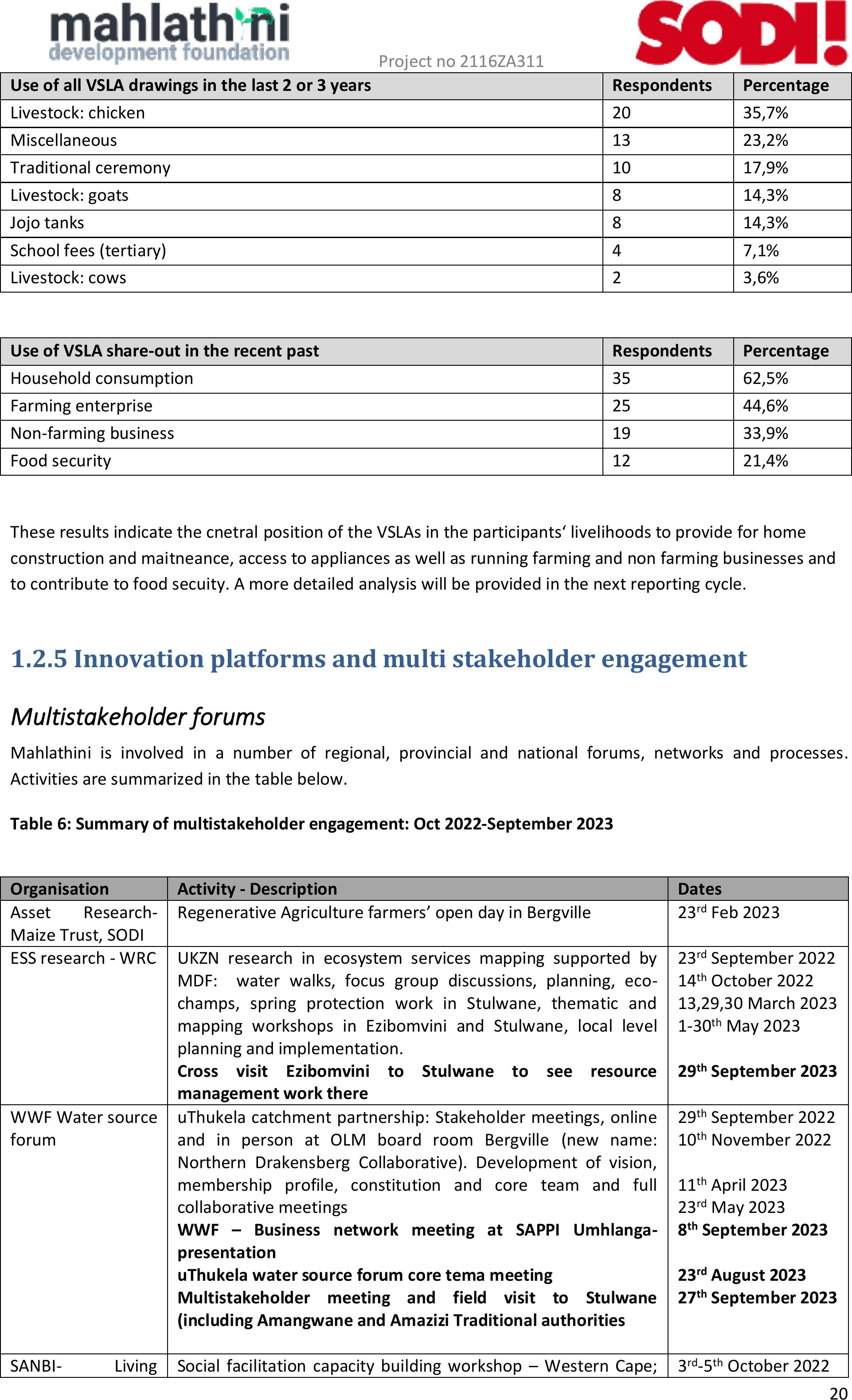
Project no 2116ZA311
20
Use of all VSLA drawings in the last 2 or 3 years
Respondents
Percentage
Livestock: chicken
20
35,7%
Miscellaneous
13
23,2%
Traditional ceremony
10
17,9%
Livestock: goats
8
14,3%
Jojo tanks
8
14,3%
School fees (tertiary)
4
7,1%
Livestock: cows
2
3,6%
Use of VSLA share-out in the recent past
Respondents
Percentage
Household consumption
35
62,5%
Farming enterprise
25
44,6%
Non-farming business
19
33,9%
Food security
12
21,4%
These results indicate the cnetral position of the VSLAs in the participants‘ livelihoods to provide for home
construction and maitneance, access to appliances as well as running farming and non farming businesses and
to contribute to food secuity. A more detailed analysis will be provided in the next reporting cycle.
1.2.5 Innovation platforms and multi stakeholder engagement
Multistakeholder forums
Mahlathini is involved in a number of regional, provincial and national forums, networks and processes.
Activities are summarized in the table below.
Table 6: Summary of multistakeholder engagement: Oct 2022-September 2023
Organisation
Activity - Description
Dates
Asset Research-
Maize Trust, SODI
Regenerative Agriculture farmers’ open day in Bergville
23rd Feb 2023
ESS research - WRC
UKZN research in ecosystem services mapping supported by
MDF: water walks, focusgroup discussions, planning, eco-
champs, spring protection work in Stulwane, thematic and
mapping workshops in Ezibomvini and Stulwane, local level
planning and implementation.
Cross visit Ezibomvini to Stulwane tosee resource
management work there
23rd September 2022
14th October 2022
13,29,30 March 2023
1-30th May 2023
29th September 2023
WWF Water source
forum
uThukela catchment partnership: Stakeholder meetings, online
and in person at OLM board room Bergville (new name:
Northern Drakensberg Collaborative). Development of vision,
membership profile, constitution and core team and full
collaborative meetings
WWF –Business network meeting at SAPPI Umhlanga-
presentation
uThukela water source forum core tema meeting
Multistakeholder meeting and field visit to Stulwane
(including Amangwane and Amazizi Traditional authorities
29th September 2022
10th November 2022
11th April 2023
23rd May 2023
8th September 2023
23rd August 2023
27th September 2023
SANBI- Living
Social facilitation capacity building workshop –Western Cape;
3rd-5th October 2022
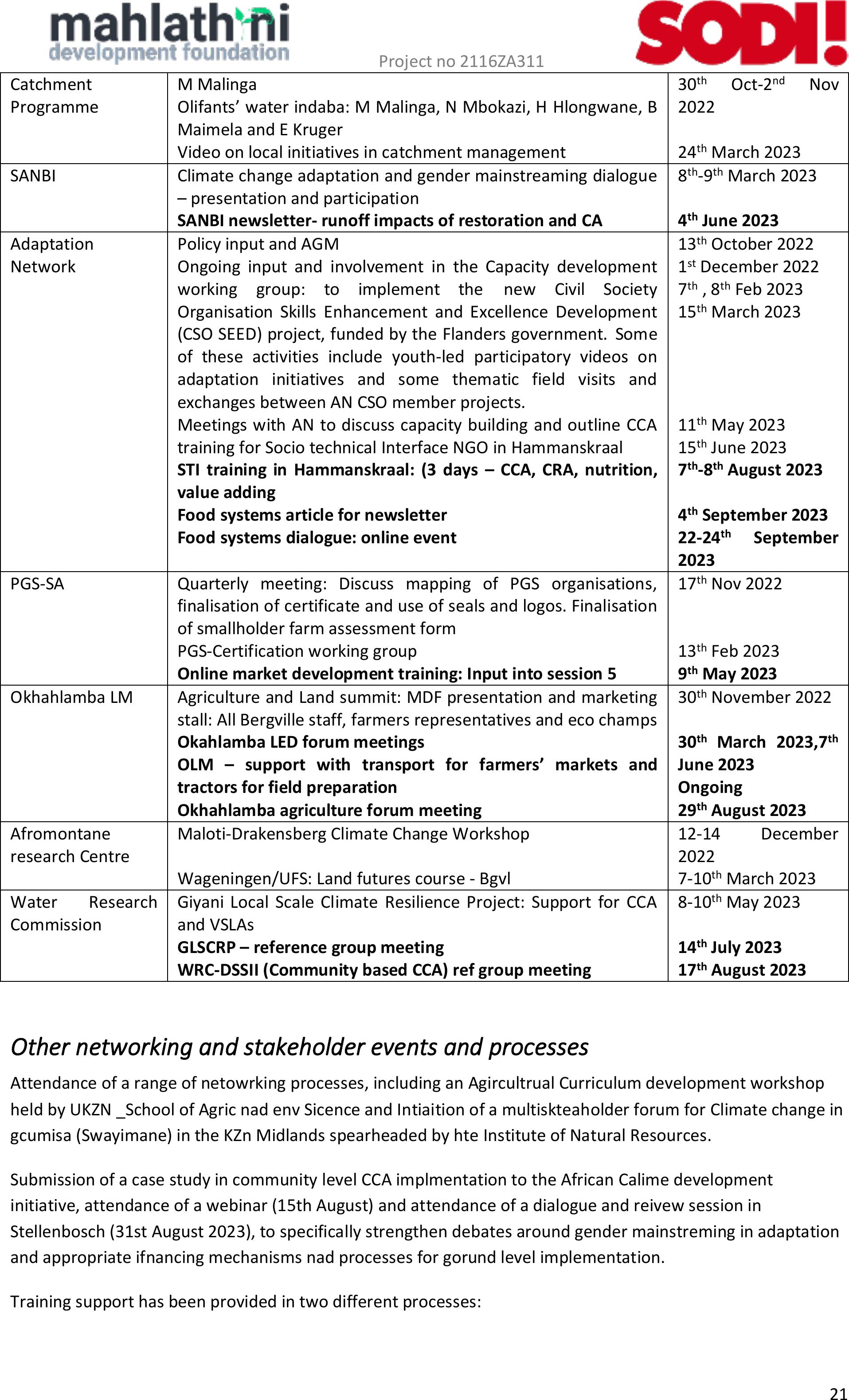
Project no 2116ZA311
21
Other networking and stakeholder events andprocesses
Attendance of a range of netowrking processes, including an Agircultrual Curriculum development workshop
held by UKZN _School of Agric nad env Sicence and Intiaition of a multiskteaholder forum for Climate change in
gcumisa (Swayimane) in the KZn Midlands spearheaded by hte Institute of Natural Resources.
Submission of a case study in community level CCA implmentation to the African Calime development
initiative, attendance of a webinar (15th August) and attendance of a dialogue and reivew session in
Stellenbosch (31st August 2023), to specifically strengthen debates around gender mainstreming in adaptation
and appropriate ifnancing mechanisms nad processes for gorund level implementation.
Training support has been provided in two different processes:
Catchment
Programme
M Malinga
Olifants’ water indaba: M Malinga, N Mbokazi, H Hlongwane, B
Maimela and E Kruger
Video on local initiatives in catchment management
30thOct-2ndNov
2022
24th March 2023
SANBI
Climate change adaptation and gender mainstreaming dialogue
– presentation and participation
SANBI newsletter- runoff impacts of restoration and CA
8th-9th March 2023
4th June 2023
Adaptation
Network
Policy input and AGM
Ongoing inputand involvement in the Capacity development
working group: to implement thenewCivilSociety
Organisation Skills Enhancement and Excellence Development
(CSO SEED) project, funded by the Flanders government.Some
of these activities include youth-led participatory videos on
adaptation initiatives and some thematic field visits and
exchanges between AN CSO member projects.
Meetings with AN to discuss capacity building and outline CCA
training for Socio technical Interface NGO in Hammanskraal
STI training in Hammanskraal: (3 days –CCA, CRA, nutrition,
value adding
Food systems article for newsletter
Food systems dialogue: online event
13th October 2022
1st December 2022
7th , 8th Feb 2023
15th March 2023
11th May 2023
15th June 2023
7th-8th August 2023
4th September 2023
22-24thSeptember
2023
PGS-SA
Quarterly meeting: Discuss mapping of PGS organisations,
finalisation of certificate and use of seals and logos. Finalisation
of smallholder farm assessment form
PGS-Certification working group
Online market development training: Input into session 5
17th Nov 2022
13th Feb 2023
9th May 2023
Okhahlamba LM
Agriculture and Land summit: MDF presentation and marketing
stall: All Bergville staff, farmers representatives and eco champs
Okahlamba LED forum meetings
OLM –support with transport for farmers’ markets and
tractors for field preparation
Okhahlamba agriculture forum meeting
30th November 2022
30thMarch 2023,7th
June 2023
Ongoing
29th August 2023
Afromontane
research Centre
Maloti-Drakensberg Climate Change Workshop
Wageningen/UFS: Land futures course - Bgvl
12-14 December
2022
7-10th March 2023
Water Research
Commission
Giyani Local Scale Climate Resilience Project: Support for CCA
and VSLAs
GLSCRP – reference groupmeeting
WRC-DSSII (Community based CCA) ref group meeting
8-10th May 2023
14th July 2023
17th August 2023
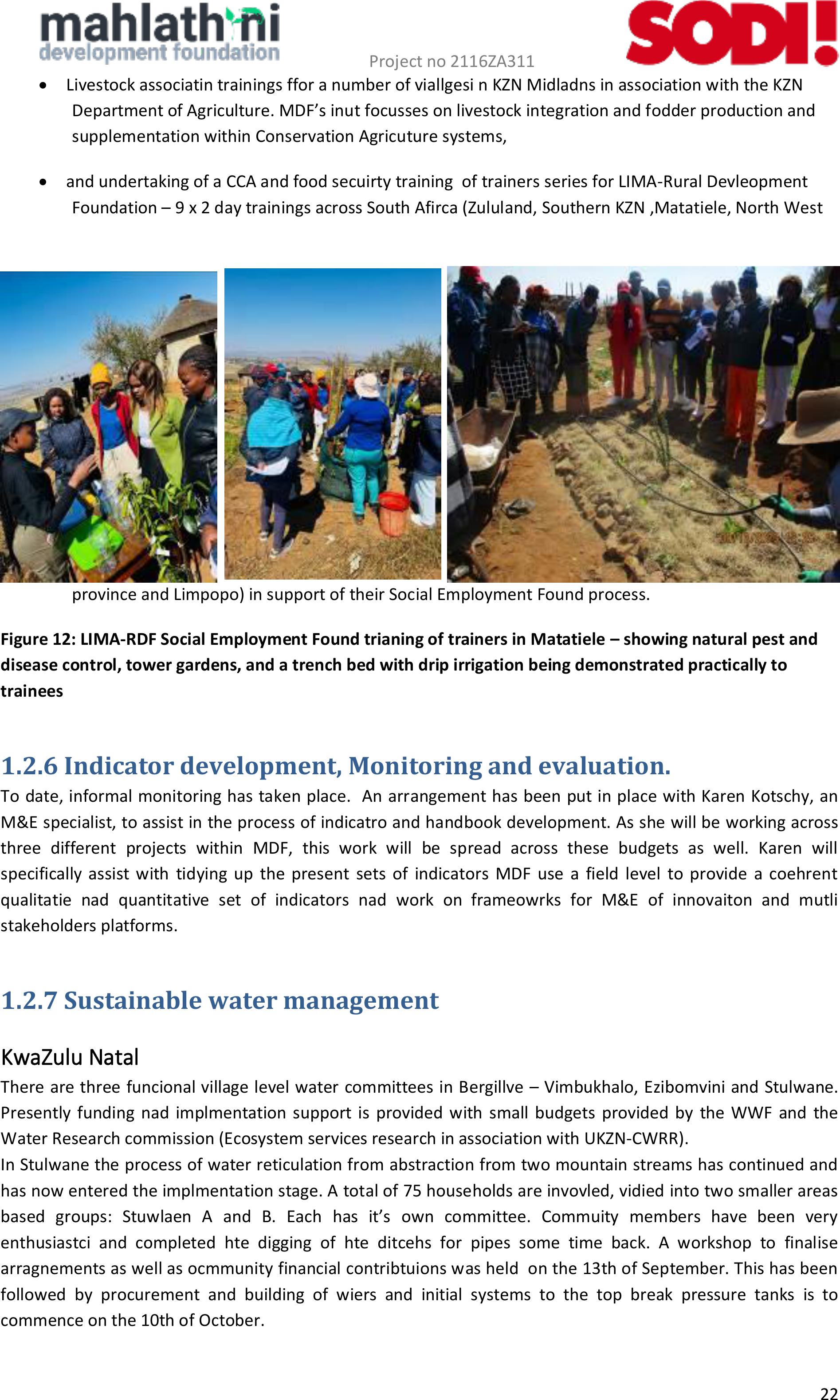
Project no 2116ZA311
22
•Livestock associatin trainings ffor a number of viallgesi n KZN Midladns in association with the KZN
Department of Agriculture. MDF’s inut focusses on livestock integration and fodder production and
supplementation within Conservation Agricuture systems,
•and undertaking of a CCA and food secuirty training of trainers series for LIMA-Rural Devleopment
Foundation – 9 x 2 day trainings across South Afirca (Zululand, Southern KZN ,Matatiele, North West
province and Limpopo) in support of their Social Employment Found process.
Figure 12: LIMA-RDF Social Employment Found trianing of trainers in Matatiele – showing natural pest and
disease control, tower gardens, and a trench bed with drip irrigation being demonstrated practically to
trainees
1.2.6 Indicator development, Monitoring and evaluation.
To date, informal monitoring has taken place. An arrangement hasbeen put in place with Karen Kotschy, an
M&E specialist, to assist in the process of indicatro and handbook development. As she will be working across
three different projects within MDF, this work will be spread across these budgets as well. Karen will
specifically assist with tidying upthe presentsets of indicators MDF use a field level to providea coehrent
qualitatie nad quantitative set of indicators nad work on frameowrks for M&E of innovaiton and mutli
stakeholders platforms.
1.2.7 Sustainable water management
KwaZulu Natal
There are threefuncional village level water committees in Bergillve –Vimbukhalo, Ezibomvini and Stulwane.
Presently funding nad implmentation support is provided with small budgets provided by the WWF and the
Water Research commission (Ecosystem services research in association with UKZN-CWRR).
In Stulwane the processof water reticulation from abstraction from two mountain streams has continued and
has now entered the implmentation stage. A total of 75 households are invovled, vidied into two smaller areas
based groups: Stuwlaen Aand B. Eachhas it’s own committee. Commuity members have been very
enthusiastci and completed hte digging of hte ditcehs for pipes some time back. A workshop to finalise
arragnements as well as ocmmunity financial contribtuions was held on the 13th of September. This has been
followed by procurement and building of wiers and initial systems to the top break pressure tanks is to
commence on the 10th of October.
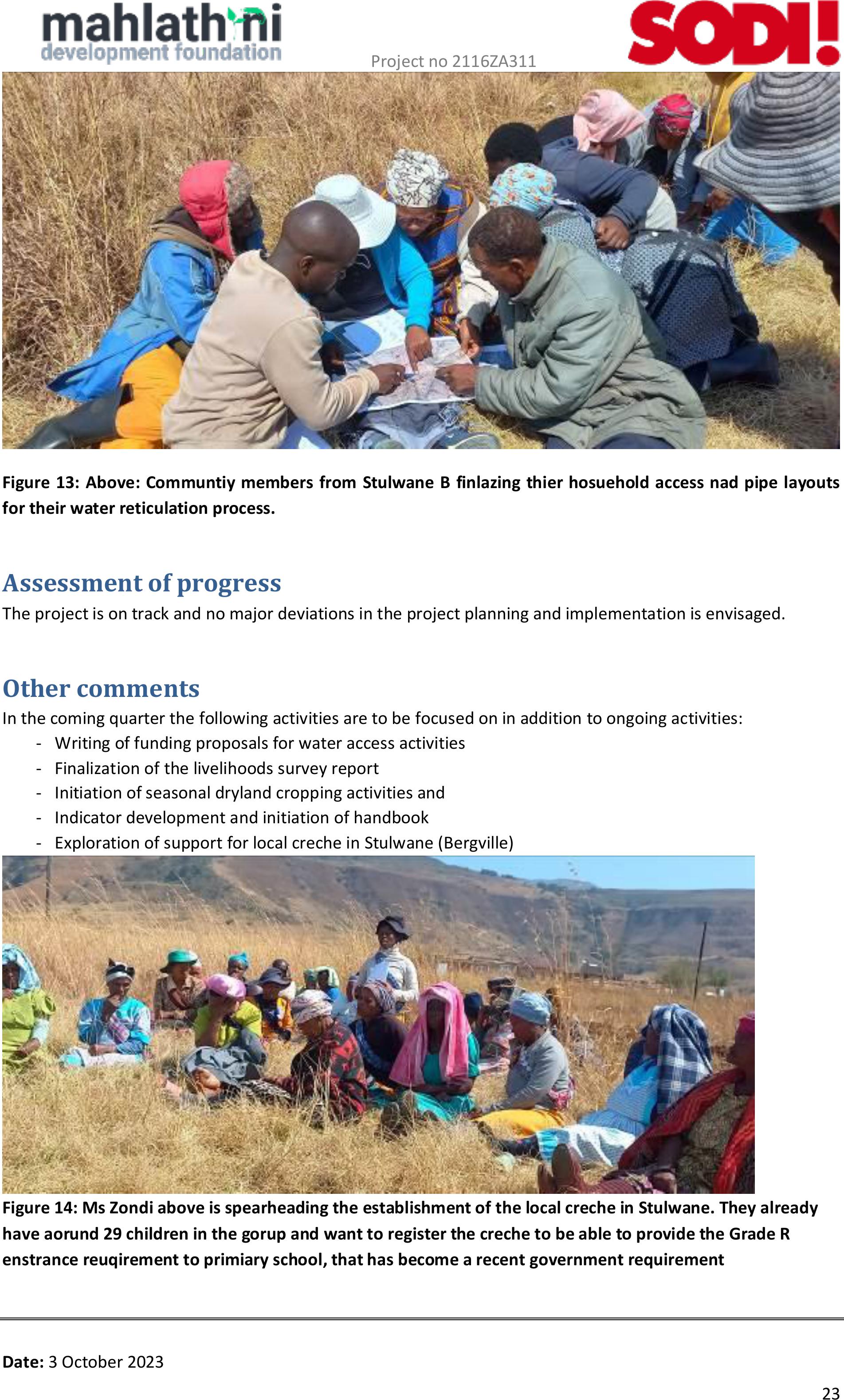
Project no 2116ZA311
23
Figure 13: Above: Communtiy members from Stulwane B finlazing thier hosuehold accessnad pipe layouts
for their water reticulation process.
Assessment of progress
The project is on track and no major deviations in the project planning and implementation is envisaged.
Other comments
In the coming quarter the following activities are to be focused on in addition to ongoing activities:
-Writing of funding proposals for water access activities
-Finalization of the livelihoods survey report
-Initiation of seasonal dryland cropping activities and
-Indicator development and initiation of handbook
-Exploration of support for local creche in Stulwane (Bergville)
Figure 14: Ms Zondi above is spearheading the establishment of the local creche in Stulwane. They already
have aorund 29 children in the gorup and want to register the creche to be able to provide the Grade R
enstrance reuqirement to primiary school, that has become a recent government requirement
Date: 3 October 2023
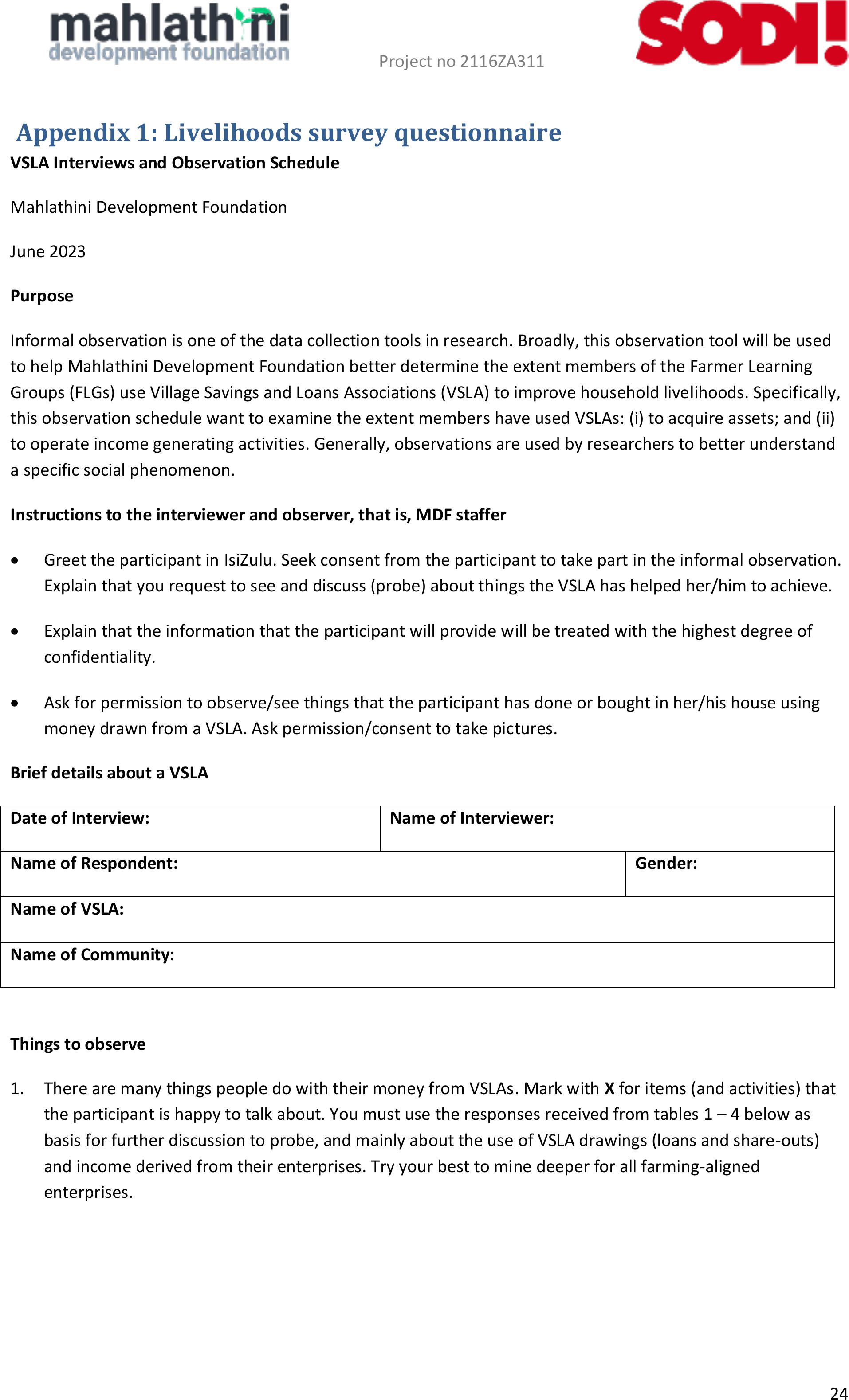
Project no 2116ZA311
24
Appendix 1: Livelihoods survey questionnaire
VSLA Interviews and Observation Schedule
Mahlathini Development Foundation
June 2023
Purpose
Informal observation is one of the data collection tools in research. Broadly, this observation tool will be used
to help Mahlathini Development Foundation better determine the extent members of the Farmer Learning
Groups (FLGs) use Village Savings and Loans Associations (VSLA) to improve household livelihoods.Specifically,
this observation schedule want to examine the extent members have used VSLAs: (i) to acquire assets; and (ii)
to operate income generating activities. Generally, observations are used by researchers to better understand
a specific social phenomenon.
Instructions to the interviewer and observer, that is, MDF staffer
•Greet the participant in IsiZulu. Seek consent from the participant to take part in the informal observation.
Explain that you request to see and discuss (probe) about things the VSLA has helped her/him to achieve.
•Explain that the information that the participant will provide will be treated with the highest degree of
confidentiality.
•Ask for permission to observe/see things that the participant has done or bought in her/his house using
money drawn from a VSLA. Ask permission/consent to take pictures.
Brief details about a VSLA
Date of Interview:
Name of Interviewer:
Name of Respondent:
Gender:
Name of VSLA:
Name of Community:
Things to observe
1.There are many things people do with their money from VSLAs. Mark with X for items (and activities) that
the participant is happy to talk about. You must use the responses received from tables 1 – 4 below as
basis for further discussion to probe, and mainly about the use of VSLA drawings (loans and share-outs)
and income derived from their enterprises. Try your best to mine deeper for all farming-aligned
enterprises.
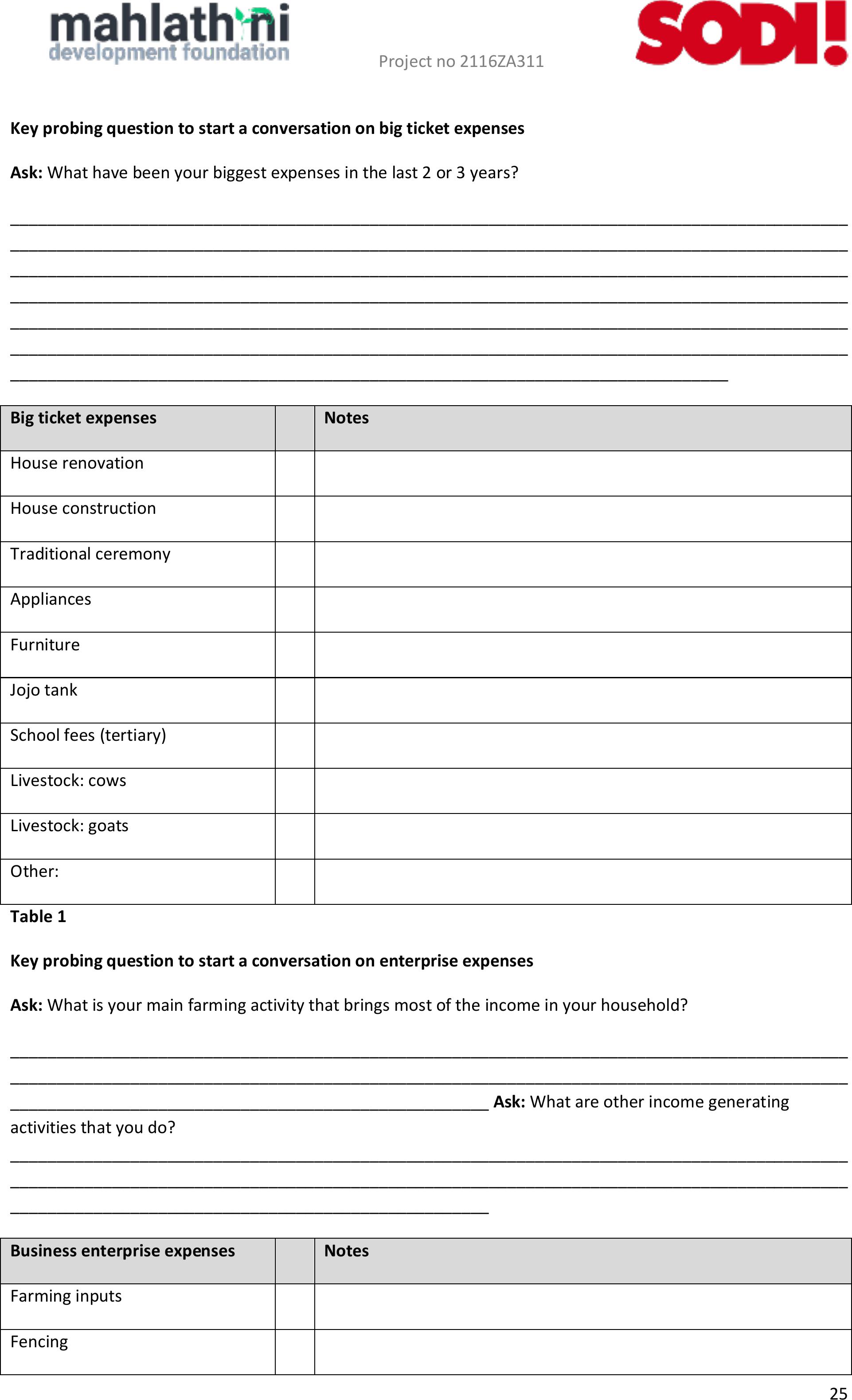
Project no 2116ZA311
25
Key probing question to start a conversation on big ticket expenses
Ask: What have been your biggest expenses in the last 2 or 3 years?
___________________________________________________________________________________________
___________________________________________________________________________________________
___________________________________________________________________________________________
___________________________________________________________________________________________
___________________________________________________________________________________________
___________________________________________________________________________________________
______________________________________________________________________________
Big ticket expenses
Notes
House renovation
House construction
Traditional ceremony
Appliances
Furniture
Jojo tank
School fees (tertiary)
Livestock: cows
Livestock: goats
Other:
Table 1
Key probing question to start a conversation on enterprise expenses
Ask: What is your main farming activity that brings most of the income in your household?
___________________________________________________________________________________________
___________________________________________________________________________________________
____________________________________________________ Ask: What are other income generating
activities that you do?
___________________________________________________________________________________________
___________________________________________________________________________________________
____________________________________________________
Business enterprise expenses
Notes
Farming inputs
Fencing

Project no 2116ZA311
26
Business enterprise expenses
Notes
Water infrastructure (pipes)
Retailing: clothes
Retailing: tuck shop
Retailing: other
Garment making
Broilers
Egg layers
Other:
Table 2
Ask: Do you have other expenses that drain your income? What are they?
Other expenses
Notes
School transport
Isipheko for traditional
ceremonies
Isipheko for funerals
Funeral insurance
Table 3
Other expenses not listed (describe them below)
Table 4

Project no 2116ZA311
27
Key probing question to start a conversation on items/assets bought, activities done and expenses paid for
by drawings from the VSLA (loans and share-outs)
Ask: In the last 2 or 3 years, what you bought or done with the money you have received from your
VSLA/Savings Group? Are you happy to show me what you have done?
___________________________________________________________________________________________
___________________________________________________________________________________________
____________________________________________________
2.While walking around the household/or sitting in the house, record everything that you see and that
contributes to household livelihoods. For instance, in the yard you may see newly installed fence and
gates, jojo tank, fruit trees, well-cared garden, cattle kraal, indigenous chickens, goats, stack of concrete
blocks, sand and stone, cement, baking pans, lounge suite, stoves, deep freezers, refrigerators, television
sets, DSTV dish, etc.
Recordof what you see (observation)
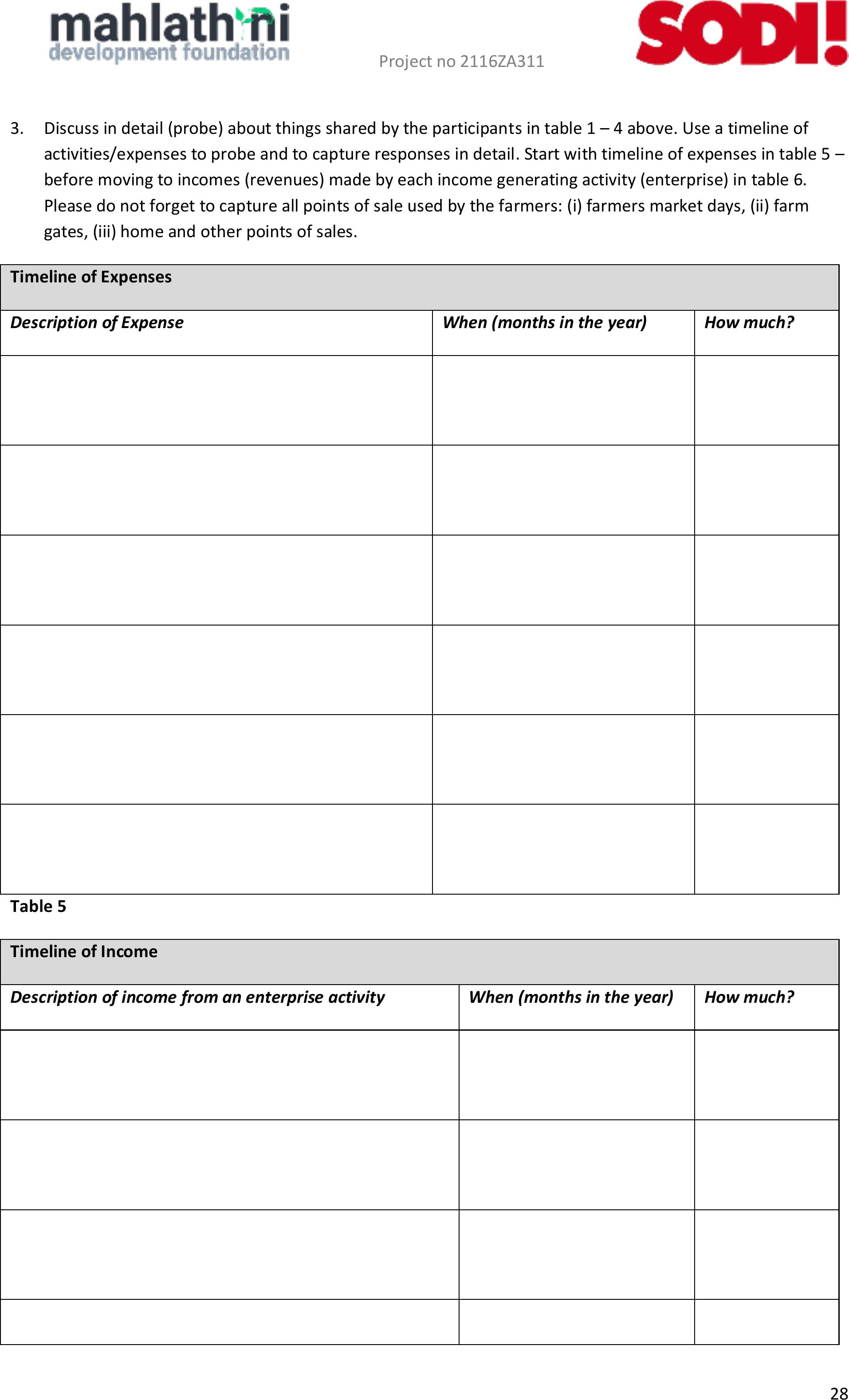
Project no 2116ZA311
28
3.Discuss in detail (probe) about things shared by the participants in table 1 – 4 above. Use a timeline of
activities/expenses to probe and to capture responses in detail. Start with timeline of expenses in table 5 –
before moving to incomes (revenues) made by each income generating activity (enterprise) in table 6.
Please do not forget to capture all points of sale used by the farmers: (i) farmers market days, (ii) farm
gates, (iii) home and other points of sales.
Timeline of Expenses
Description ofExpense
When (months in the year)
How much?
Table 5
Timeline of Income
Description of income from an enterprise activity
When (months in the year)
How much?

Project no 2116ZA311
29
Table 6
Table 6 should complete the interview, however, you must ensure that the following questions have been
asked during your discussion.
4.Questions you must not miss.
4.1.What are your main sources of income?
_______________________________________________________________________________________
_______________________________________________________________________________________
___________________________________________________
4.2.Is your participation in your savings group/s a livelihood activity? Please explain in detail.
_______________________________________________________________________________________
_______________________________________________________________________________________
___________________________________________________
4.3.On what basis did you choose your savings group/s as your livelihood activity? In other words, what are
the main benefits that you get by participating in your group/s?
_______________________________________________________________________________________
_______________________________________________________________________________________
_______________________________________________________________________________________
_______________________________________________________________________________________
___________________________
4.4.Do you participate in more than one group? How many? _______________ Why to do you participate in
these groups?
_______________________________________________________________________________________
_______________________________________________________________________________________
_______________________________________________________________________________________
_______________________________________
4.5.Do you take loans from your savings groups?______________________________________
4.6.In the recent past, what have you used loans for? For food? For farming? For a business? Probe deeply.
_______________________________________________________________
_______________________________________________________________________________________
_______________________________________________________________________________________
_______________________________________________________________________________________
_______________________________________________________________________________________
___________________________
4.7.In the recent past, what have you used your share-out for? For food? For farming? For a business? Probe
deeply _______________________________________________________

Project no 2116ZA311
30
_______________________________________________________________________________________
_______________________________________________________________________________________
_______________________________________________________________________________________
_______________________________________
4.8.What other assets have you accumulated since participating in your group/s?
_______________________________________________________________________________________
_______________________________________________________________________________________
_______________________________________________________________________________________
_______________________________________
4.9.What types of income generating activities (enterprises) do you have now?
_______________________________________________________________________________________
_______________________________________________________________________________________
___________________________________________________
4.10.Where do you want to see your VSLA in the next 10 years? ________________________
_______________________________________________________________________________________
_______________________________________________________________________________________
___________________________________________________